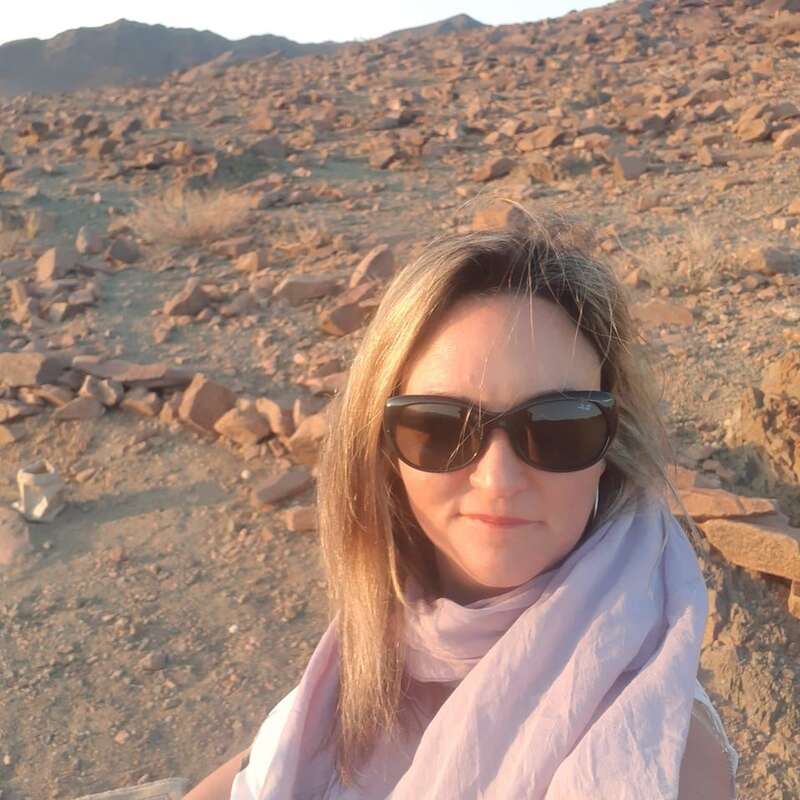About Damaraland Camp
To stay at Damaraland Camp is to experience the hospitality of the local community in a truly beautiful setting.
Building on a ground-breaking partnership between Wilderness Safaris and the Torra Conservancy, the camp is now run almost entirely by members of the community. Since its foundation in 1996, it has remained true to its original eco-friendly ethos – and is instrumental in supporting both education and conservation in the surrounding area.
But this is no simple bushcamp. Airy, split-level chalets of canvas and wood nestle into the hillside, their thatched roofs blending with the rolling grassland, their patios offering scenic views along the valley.
Uncluttered furnishings and a muted décor run through the chalets to the stone-built living area and outside, where comfortable sofas take in the view, and parasols shade an inviting pool. On a warm night, stroll to the “boma” for a convivial dinner beneath a star-studded sky. And when it’s cooler, there’s always a campfire to ward off the chill.
While most visitors come for the desert-adapted elephant, and perhaps the rock art at Twyfelfontein, do make time for a guided walk above the camp.
Our view
A joint venture between a good safari company, Wilderness Safaris, and the people of the local Torra Conservancy, Damaraland Camp has proved hugely successful. It's a model of how community-based tourism can work – and is looked at by other camps in Africa for inspiration. The camp has a great atmosphere with friendly, happy staff who clearly love what they do and are committed to making your stay as enjoyable and memorable as possible. Added to that, Damaraland Camp is located in one of the most beautiful wilderness areas in Namibia, where the effect of the light brings constantly changing scenery. It's a great place to spend two or three nights.
Accommodation
10 chalets
Children
Not recommended.
Open
All year
Activities

4WD Safari

Birdwatching

Cultural excursion

Guided walking safari

Night drive

Private activities
Traveller reviews of Damaraland Camp
126 real, un-edited reviews from Expert Africa's travellers.
Arrived 26 Jan 2025, 2 nights
"Damaraland Camp review"
Overall rating: Average
Arrived 13 Oct 2024, 4 nights
"Damaraland Camp review"
Overall rating: Excellent
Arrived 26 Sep 2024, 2 nights
"Damaraland Camp review"
Overall rating: Excellent
Arrived 2 Jun 2024, 3 nights
"Damaraland Camp review"
Overall rating: Excellent
Arrived 13 Apr 2024, 3 nights
"Damaraland Camp review"
Overall rating: Excellent
Arrived 3 Sep 2023, 3 nights
"Damaraland Camp review"
Overall rating: Excellent
Arrived 7 Aug 2023, 2 nights
"Damaraland Camp review"
Overall rating: Excellent
Arrived 31 Jan 2023, 2 nights
"Damaraland Camp review"
Overall rating: Excellent
Arrived 22 Sep 2022, 3 nights
"Damaraland Camp review"
Overall rating: Good
Arrived 10 Sep 2022, 2 nights
"Damaraland Camp review"
Overall rating: Excellent




























Expert Africa's gallery
When we travel we take lots of photos ourselves to give you a real and un-edited view of the safaris. See our 56 pictures and 1 videos of Damaraland Camp to get the candid view.
View gallerySafaris visiting Damaraland Camp
Just ideas, we'll always tailor-make a trip for you
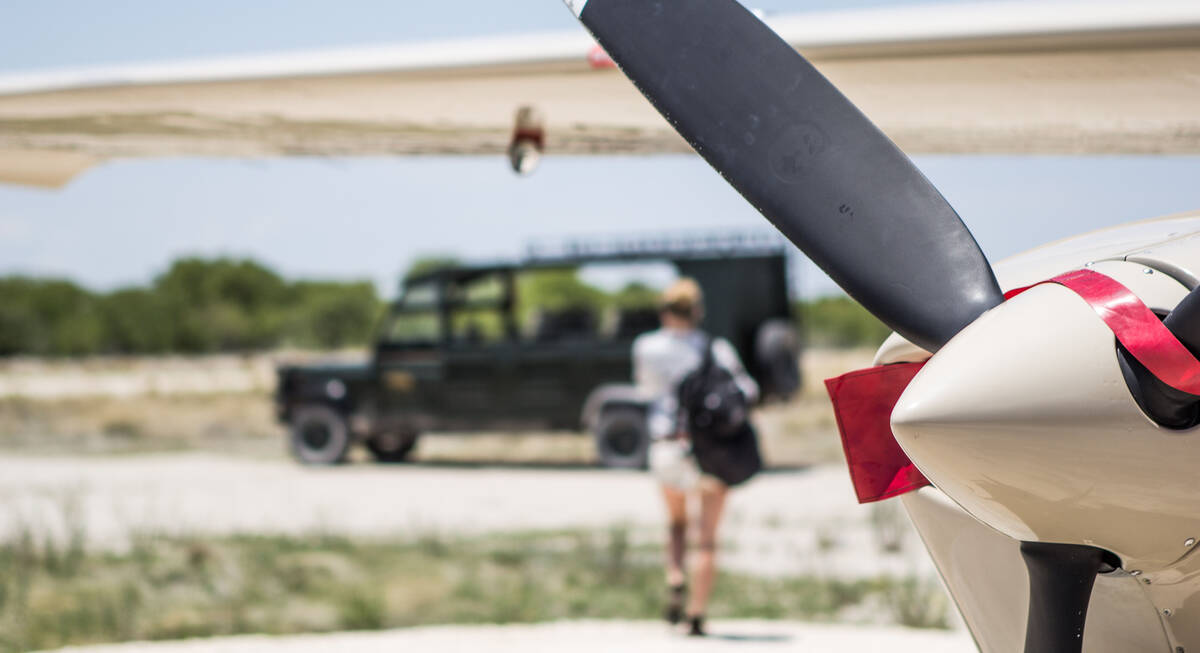
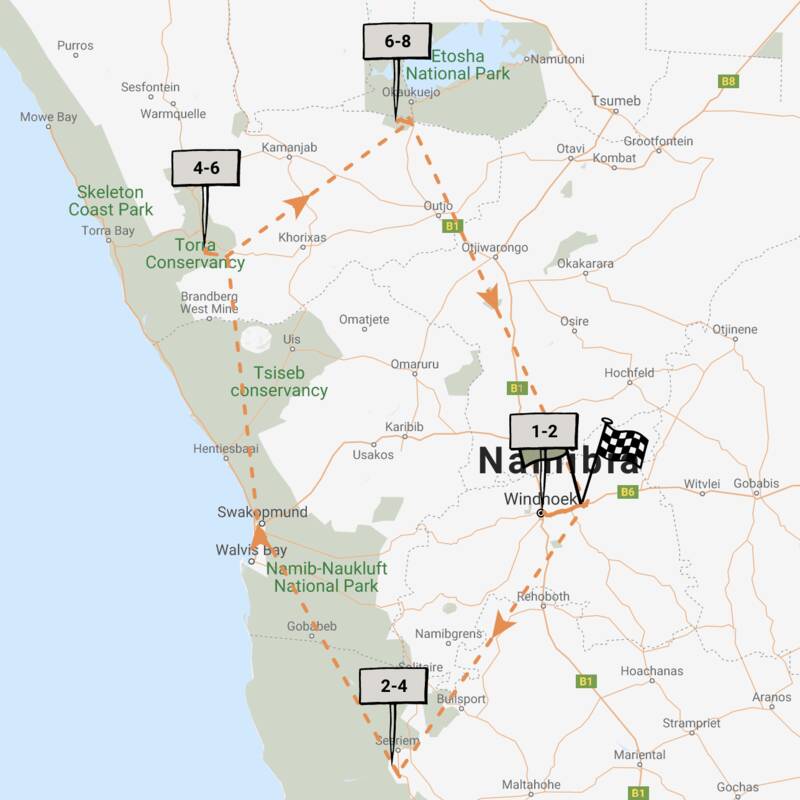
Bateleur Fly-in Safari
7 days • 4 locations • 1 country
WINDHOEK AIRPORT TO WINDHOEK AIRPORT
Classic fly-in Namibian safari staying at excellent camps. Explore Sossusvlei’s dunes and track Damaraland’s desert elephants before a safari in Etosha. Incredible scenery, good wildlife viewing and authentic cultural experiences.
Visiting Namib-Naukluft, Damaraland and 2 other areas
US$7,190 - US$9,240 per person
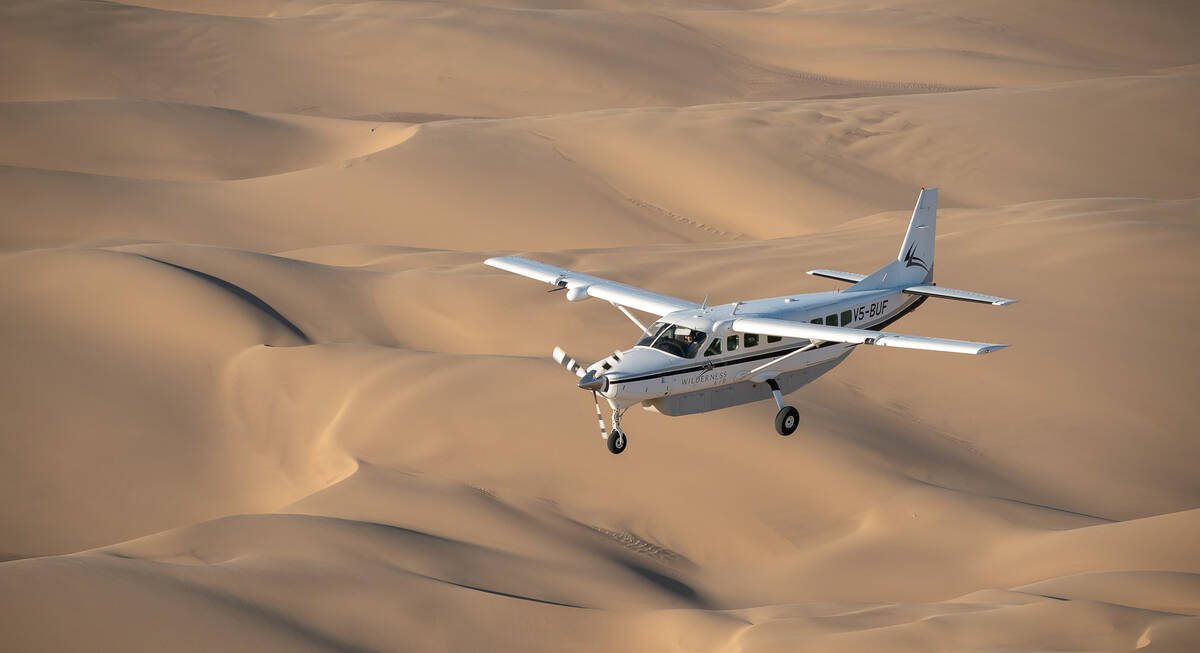
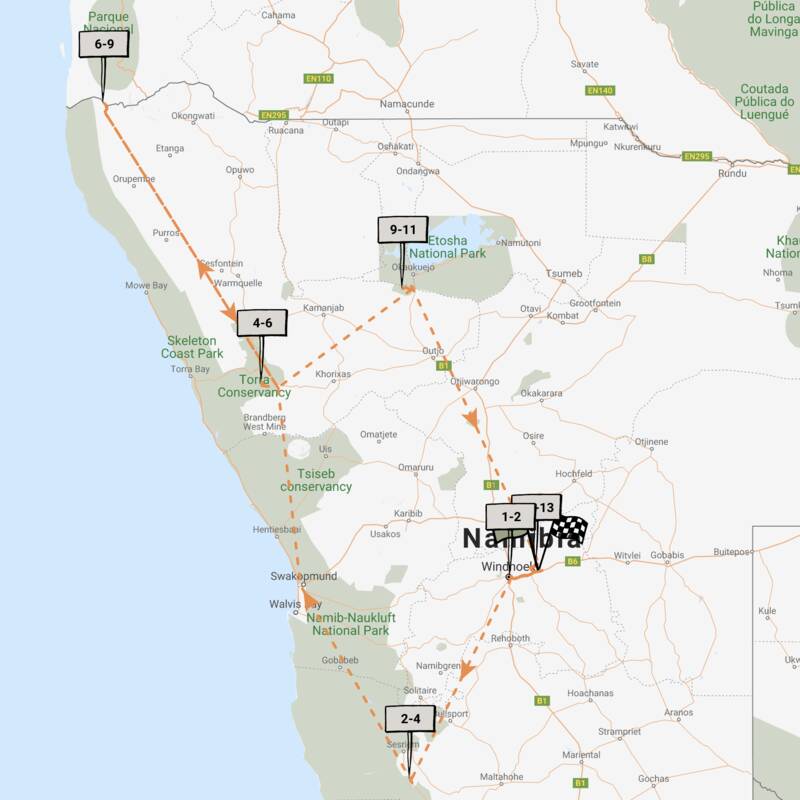
Goshawk Fly-in Safari
12 days • 6 locations • 1 country
WINDHOEK AIRPORT TO WINDHOEK AIRPORT
Discover Namibia’s remarkable landscapes, fascinating wildlife and unique cultures on this luxury adventure flying between a selection of the very best camps and lodges in the country.
Visiting NamibRand, Damaraland and 3 other areas
US$13,230 - US$19,820 per person
Damaraland Camp: Our full report
Nestled in the Huab River valley, and surrounded by low hills, Damaraland Camp was one of the earliest camps ...
... in this area of Namibia, having opened around 1996. Although it has undergone a number of renovations since then, with the chalets almost doubled in size, it retains its strong community feel, and is now part owned by the local people. The camp's secluded location makes it a great base from which to explore the many attractions of this stark but richly diverse region.
In 2009 Damaraland Camp was completely rebuilt, with staff and members of the community all pitching in. In keeping with the camp's original philosophy, emphasis continues to be placed on making everything as eco-friendly as possible whilst maintaining its high standards. The camp is now largely run by members of the local community, many of whom have been here for years – and have gradually worked their way up.
There are ten spacious chalets at Damaraland Camp. Each is light, airy and well designed, with a décor of muted beige/cream hues. Constructed of wood, adobe and canvas, they are raised up on a low decking, ensuring minimum impact on the natural vegetation and giving great views along the valley from their private patios. One chalet is located further from the others, so has more privacy, and another has two bedrooms, so is suitable for families.
Central to each split-level bedroom are twin beds on an upper step, with reading lamps and thick blocks of dark wood as bedside tables. A single step takes you to a large dressing area behind the beds, with a luggage rack and a curtained wardrobe, as well as a big writing desk with a reading lamp and comfortable chair. Each chalet has a ceiling fan above the bed, a tea/coffee station, bottled water, a fog horn (for use in an emergency), insect repellent and a safe.
From the main bedroom, an open door way which can be curtained off leads into a spacious en-suite bathroom. Here, a large rectangular mirror suspended on chains hangs above his and hers washbasins, with toiletries and washing powder for personal items. The big shower area has a mesh window with a roll-down flap.
The camp's stone-built central area, under a high thatched roof, comprises the dining area, a large fireplace, a living area with extra-deep sofas and comfortable stuffed cushions, a bar, a tea and coffee station (where there is often a tempting jar of homebaked biscuits), and a curio shop with a small library. Adjacent is a lovely oval-shaped swimming pool surrounded by shaded sunloungers, and fronted by a low deck where huge cushions and pillows beckon to admire the view.
Pre-dinner drinks are usually taken around an open campfire, under a beautiful, often very clear star-studded sky; this is a particularly good area for star-gazing.
There's a long, solid table in the main dining area, which on warm evenings is left open, but dinner is sometimes served in the outdoor "boma". A short walk in front of the camp, this is lit by paper lanterns and warmed by a campfire, so perfect for celebrating a special occasion. On cold evenings, blankets are provided to keep you warm during dinner.
The focus of activities at Damaraland Camp is on wildlife (specifically desert-adapted elephants), the stunning, ever-changing scenery and local culture. Options include two guided nature walks along either the Shepherd's Trail (this is a shorter and much easier walk) and the Damarana Trail, as well as half-day excursions to view the rock art at Twyfelfontein World Heritage Site, and nature drives into the dry riverbeds and to a recently discovered petrified forest. The camp also offers sundowner drives.
However, the main attraction for guests is a guided nature drive in an open seven-seater Land Rover in search of the area's wildlife, most notably the small herds of desert-adapted elephant that seasonally frequent the dry bed of the Huab River. There is also a very slim chance of spotting black rhino, cheetah and the elusive brown hyena if you are lucky, as well as the more common plains game – such as Hartmann's mountain zebra, giraffe, gemsbok and springbok. On our last stay in December 2016 we were lucky enough to see not only desert elephant but also some of the nomadic desert lion on a kill much to our delight: a real highlight of our trip.
Geographics
- Location
- Damaraland, Namibia
- Ideal length of stay
- Two to three nights
- Directions
- Guests flying into Damaraland Camp will be met at the airstrip, a short drive from the camp.
On a self-drive trip you can either leave you vehicle at a farmstead by the C39 and be transferred to camp (recommended for 2WD vehicles) or drive yourself to the camp (4WD only). - Accessible by
- Self-drive or Fly-and-Transfer
Food & drink
- Usual board basis
- Half Board
- Food quality
- For breakfast, guests may choose from a selection of cereals, yoghurt, fresh fruits, freshly baked warm muffins, bread, cold meats and cheese, pancakes, orange and apple juice, tea and coffee. A hot breakfast of fried eggs, bacon, fried tomatoes, mushrooms and toast can also be served, cooked to order.
On our last visit, in December 2016, lunch was a choice of game pie or vegetarian stew followed by a delicious and refreshing smoothie. The camp will also provide a lunch pack for you to take on the road; ours consisted of sandwiches, nuts, fruit and a cereal bar, with water and juice to drink.
Afternoon tea with cake is served at 4.00pm, and tea and coffee are available all day.
Dinner is a real treat at Damaraland Camp, with your waiter announcing the dinner menu in the Damara language. Expect three courses; we were served a sun-dried tomato and feta filo parcel, followed by grilled steak or chicken with rice and vegetables, and a chocolate and pistachio gelato.
During our visit the staff graced us with some traditional singing and dancing, before bidding us a lovely evening and retiring for the night. - Dining style
- Group Meals
- Dining locations
- Indoor and Outdoor Dining
- Further dining info, including room service
- No
- Drinks included
- Drinks are included with the exception of premium and imported brands.
Special interests
- Honeymoons
- Damaraland Camp is in a beautiful and tranquil location, perfect for a Namibia honeymoon. Enjoy the lovely 'honeymoon' chalet with elegant and luxurious furnishings, lots of privacy and great views down the valley and of the hills.
- See ideas for Honeymoons in Namibia
- Luxury
- Started in 1996, Damaraland Camp was Namibia’s original ‘Luxury Safari Camp’. Since then it’s been reinvented on a much grander scale. Large, well-furnished chalets have high thatched roofs whilst expansive communal areas include lounges inside and out, and an inviting swimming pool.
- See ideas for Luxury in Namibia
Children
- Attitude towards children
- The camp does not accept children under the age of 12.
- Property’s age restrictions
- No children under 12.
- Special activities & services
- None
- Equipment
- None
- Generally recommended for children
- Expert Africa does not recommend Damaraland Camp for younger children at all; it has a fairly adult atmosphere, with little to keep youngsters entertained.
Our travellers’ wildlife sightings from Damaraland Camp
Since mid-2018, many of our travellers who stayed at Damaraland Camp have kindly recorded their wildlife sightings and shared them with us. The results are below. Click an animal to see more, and here to see more on our methodology.

93% success

68% success

63% success

33% success

29% success

5% success

5% success

0% success

0% success

0% success

0% success
Communications
- Power supply notes
- The solar power system doesn’t allow charging in the rooms but there is a charging station in the main area.
- Communications
- There is a computer with internet access in the main area for guests to use, as well as complimentary WiFi.
- TV & radio
- None
- Water supply
- Borehole
- Water supply notes
- Each chalet has plumbed showers, hot and cold running water and flush toilets. Please note that the hot water is solar heated so may not be hot in the early morning.
Sustainability

Giving back to the local community
Damaraland is becoming synonymous with social commitment in Namibia. The camp has gained Five Flowers from Eco-Awards Namibia and the Silver African Responsible Tourism Award in 2017, featuring the Torra Conservancy Partnership as one of their most effective social practices. This brave partnership between Wilderness Safaris and the local community has resulted in a 352,000-hectare (869,000-acre) conservancy being proclaimed by locals. The success of the initiative is attested by the area’s flourishing wildlife and the decrease in poaching activities.
Another innovative partnership with Pack for a Purpose, a non-profit organisation, provides travellers with up-to-date information about what supplies are required for community-based projects and contributes to supplying 450 children from aged 5–18 in the town of Bergsig with school necessities. Guests are encouraged to donate general supplies such as chalk, pencils or notebooks, flash cards or reading materials as well as dictionaries or encyclopaedias.
Local children also benefit from donations and activities organised by Children in the Wilderness Namibia. This organisation aims to facilitate sustainable conservation through developing leadership abilities and educating rural children in Namibia about the environment and the opportunities it provides them with. Through running both Eco-Clubs at schools within local communities and annual camps, the programme combines leadership skills, environmental education and recreation.
Tours for guests interested in getting a taste of the local culture and the social impact of Damaraland Camp can be organised. This is a great opportunity to engage with local communities and learn about the unique heritage of the Nama-Damara, Herero and Owambo.
See more great sustainability projects in Namibia
Health & safety
- Malarial protection recommended
- Yes
- Medical care
- All the staff are first-aid trained. There is a nurse in the local village which is just a 10-minute drive away, and the nearest doctor is in Khorixas.
- Dangerous animals
- Moderate Risk
- Security measures
- Damaraland Camp is very remote and not easily accessible. Cars parked in the 2WD car park are watched by the villagers.
- Fire safety
- All the rooms and the main building have fire extinguishers.
Activities
4WD Safari
Birdwatching
Cultural excursion
Guided walking safari
Night drive
Private activities
Extras
- Disabled access
- On Request
- Laundry facilities
- Laundry is included for those staying on a full-board basis.
- Money
- There is a safe in each chalet.
- Accepted payment on location
- Cash payments may be made in Namibian dollars, South African rand, euros, US dollars and GB pounds. Visa and Mastercard are accepted, but travellers’ cheques are not.
Plan and book your trip with Expert Africa
All of our trips are tailor-made, so we'll always adapt them to suit you. Talk to an Expert and let us plan and arrange your perfect trip.

Talk to an Expert
Call or email us now! We’ll match you with the Specialist in our team who is best suited to help you. Then together we can start planning your trip.

Set up your itinerary
Based on our experience and your ideas, your specialist will create a detailed, costed itinerary. We’ll refine it together, until we have a trip that you’re perfectly happy with.

Prepare for your trip
The same Specialist will make the seamless arrangements for your trip, send you detailed travel documents, and be available to answer any questions before you depart.

Travel with peace of mind
After you set off, you’ll be cared for by our partners in Africa, most of whom have worked with Expert Africa for decades. And if you ever need us urgently, we’re available 24/7.

When you return
We love to learn about your trip, and so will always be grateful if you’ve the time to give feedback to your Specialist when you return.
Damaraland Camp's location
Look closer at the environment and surroundings of Damaraland Camp.
Other lodges in Damaraland
Alternative places to stay in this same area.
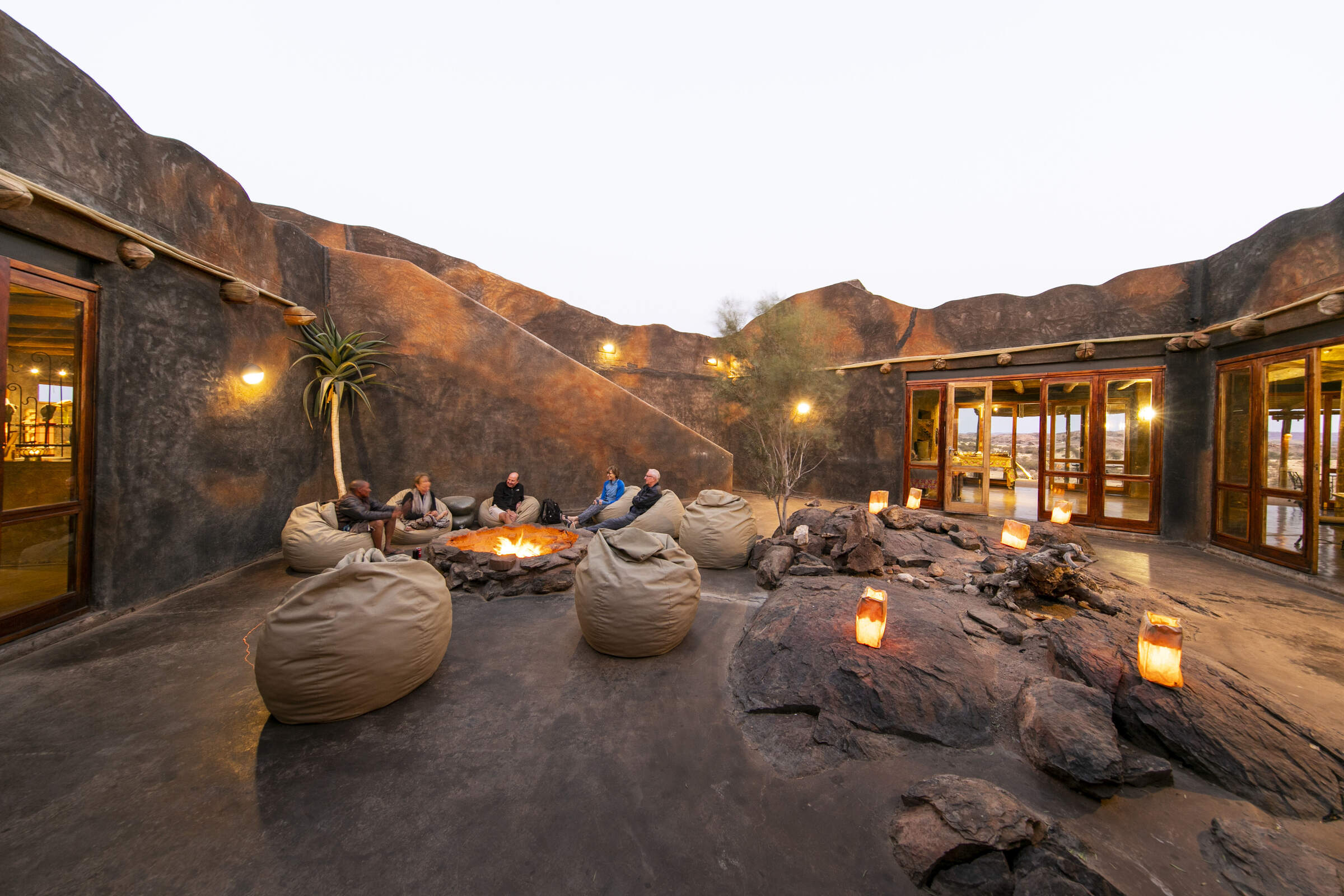
Doro Nawas
Comfortable rooms and a convenient location make the community run Doro Nawas a great base for exploring Damaraland.
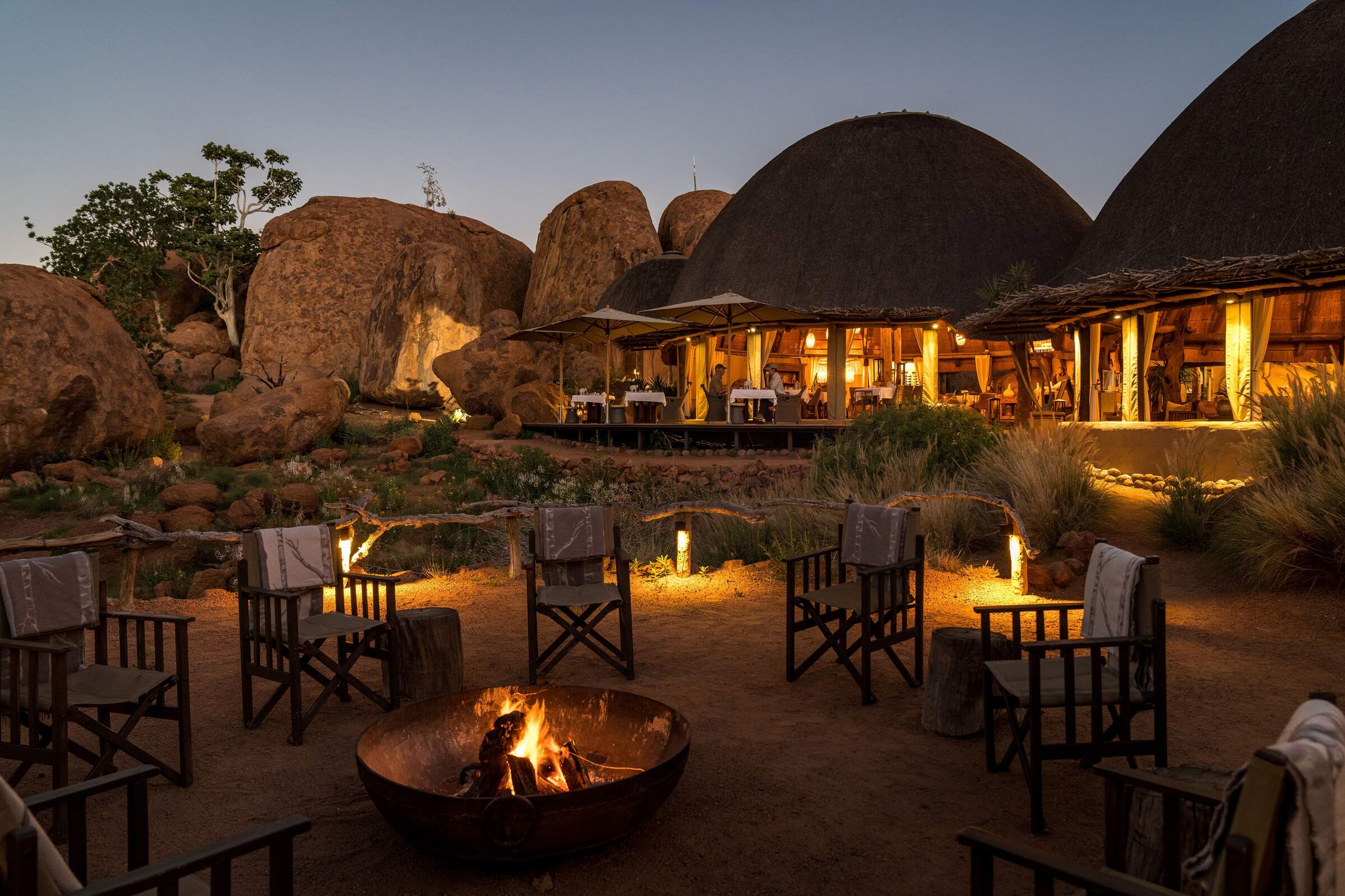
Mowani Mountain Camp
Mowani is a beautiful and stylish mountain retreat in southern Damaraland; it makes a great base for visits toTwyfelfontein.
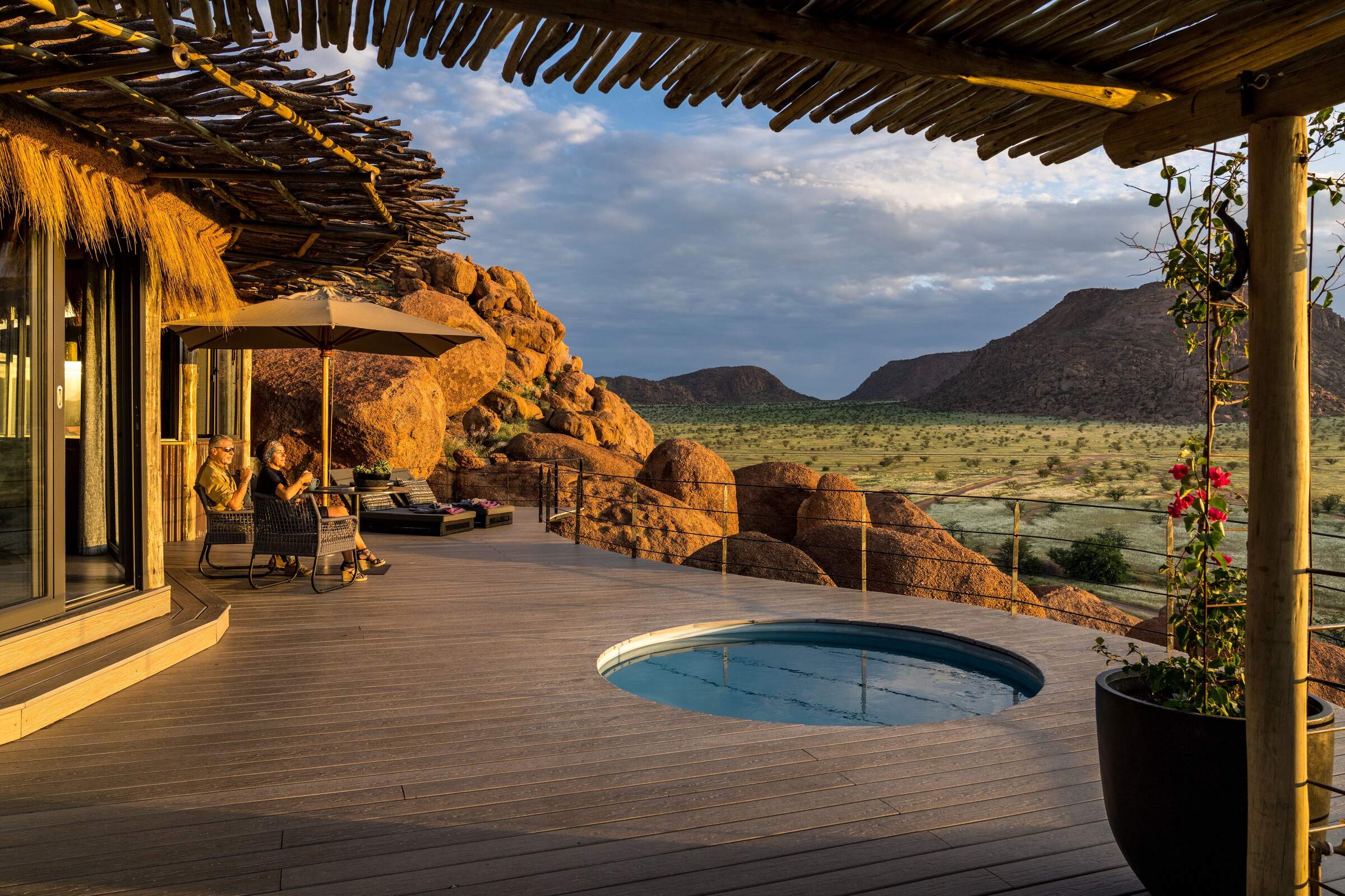
Camp Kipwe
With unusual, igloo-like rooms, open-air bathrooms and beautiful scenery, Camp Kipwe is well placed for nature and cultural excursions.
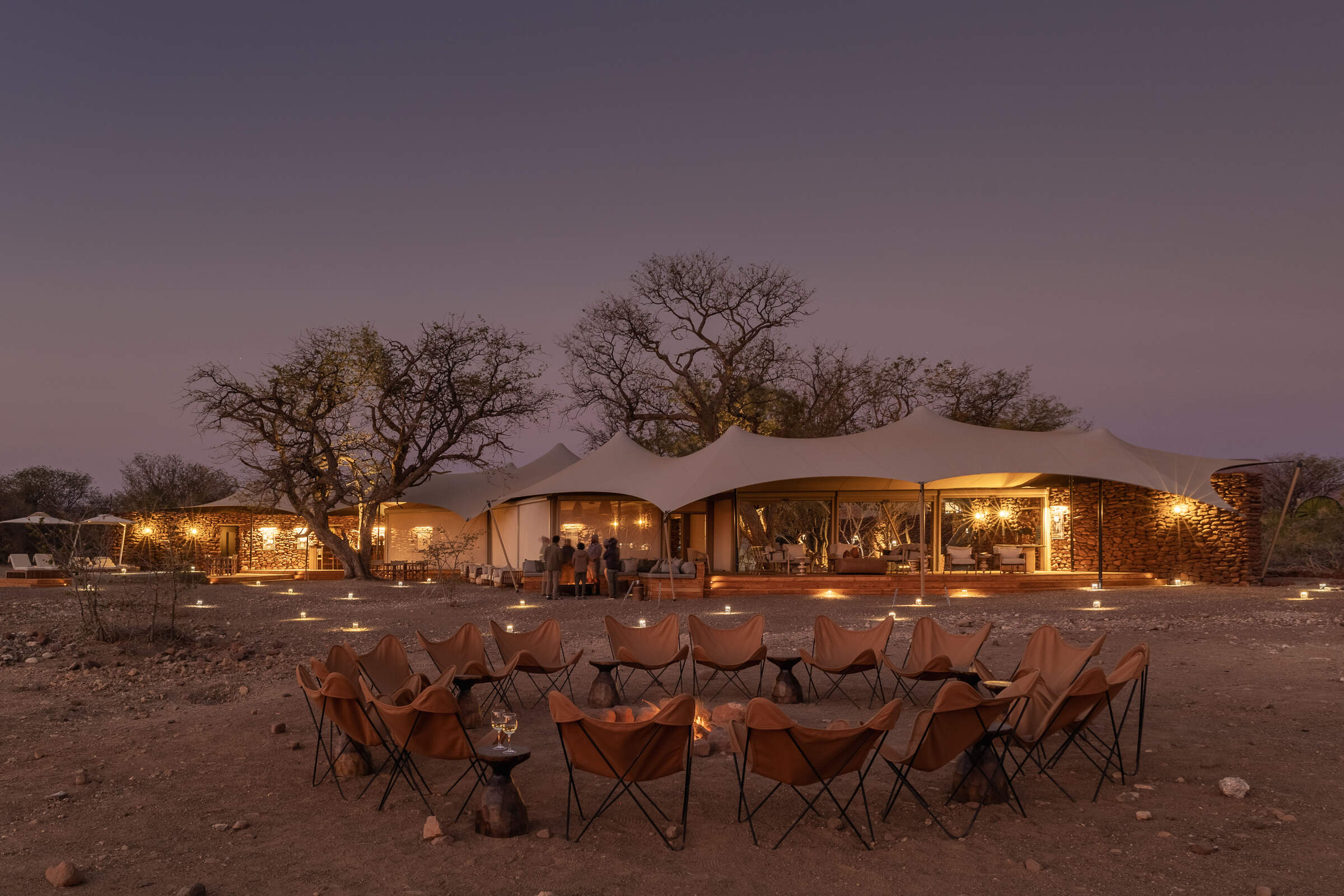
Desert Rhino Camp
Desert Rhino Camp offers a rare opportunity to track black rhino on foot in one of the last true wilderness areas – an amazing experience.
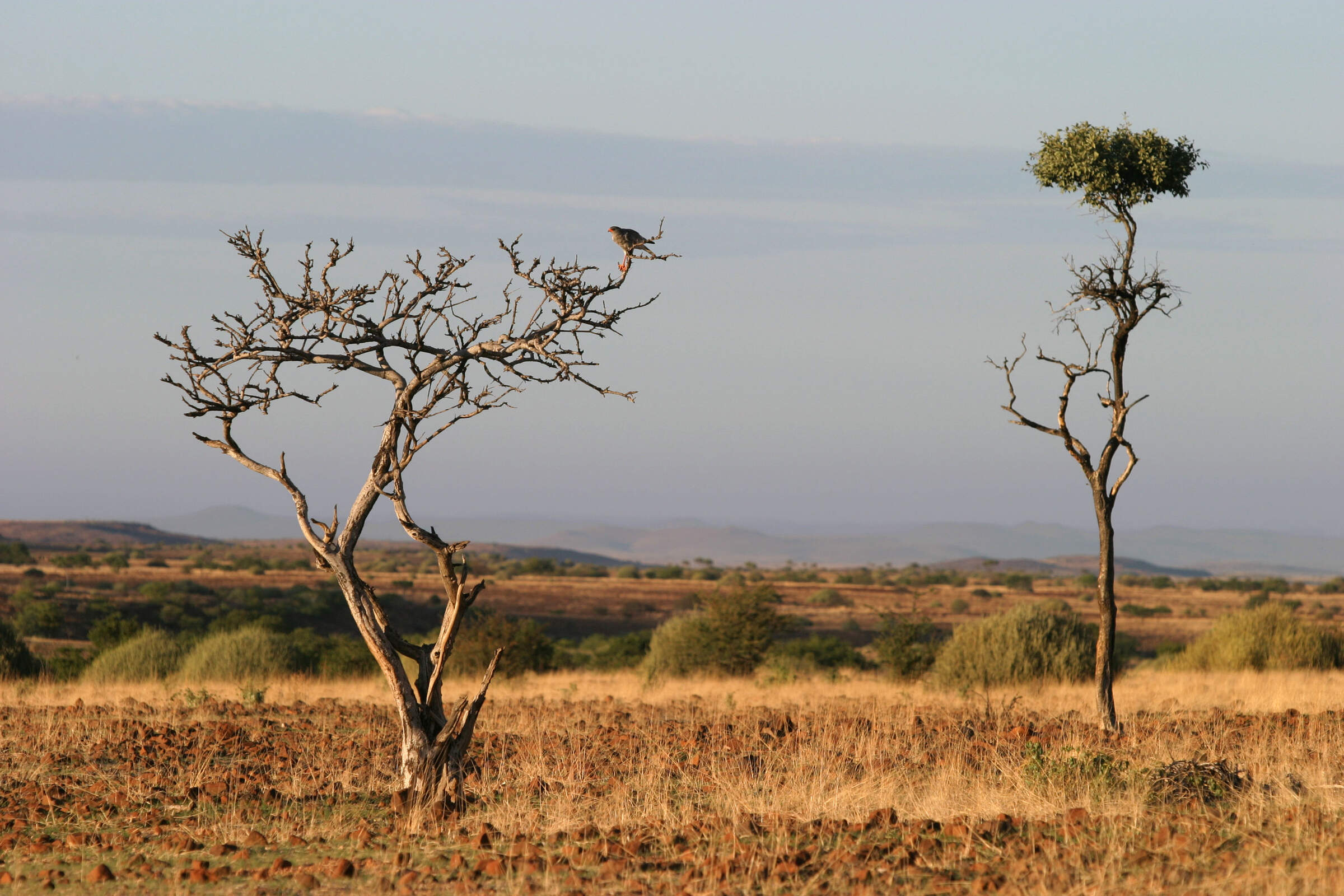
Etendeka Camp
Etendeka is an owner-run camp in the remote and less visited north of Damaraland. The camp is renowned for it's spectacular guided walking trails.
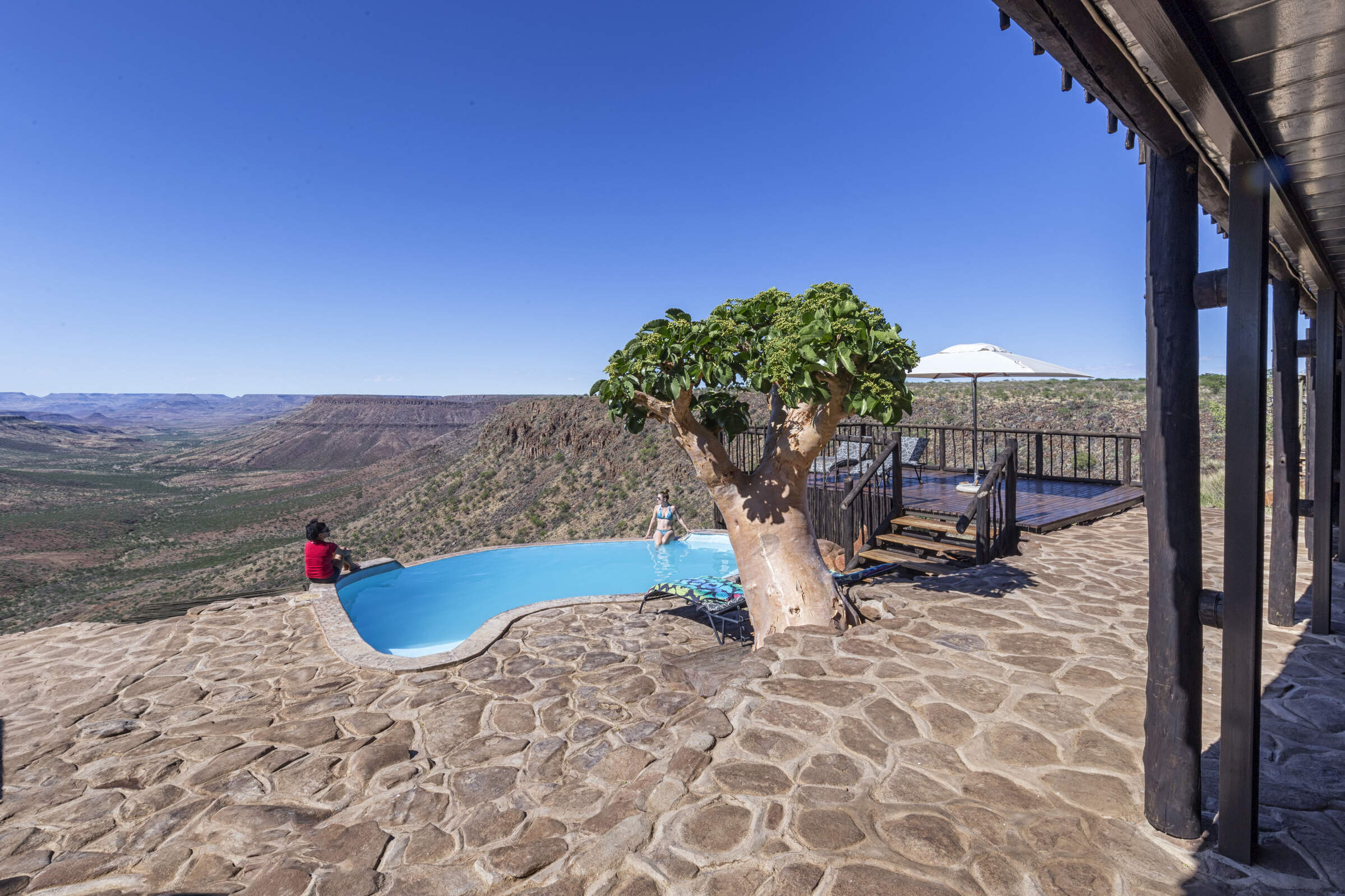
Grootberg Lodge
On the edge of an ancient plateau Grootberg Lodge has a stunning location and arguably the best views of any lodge in Namibia.
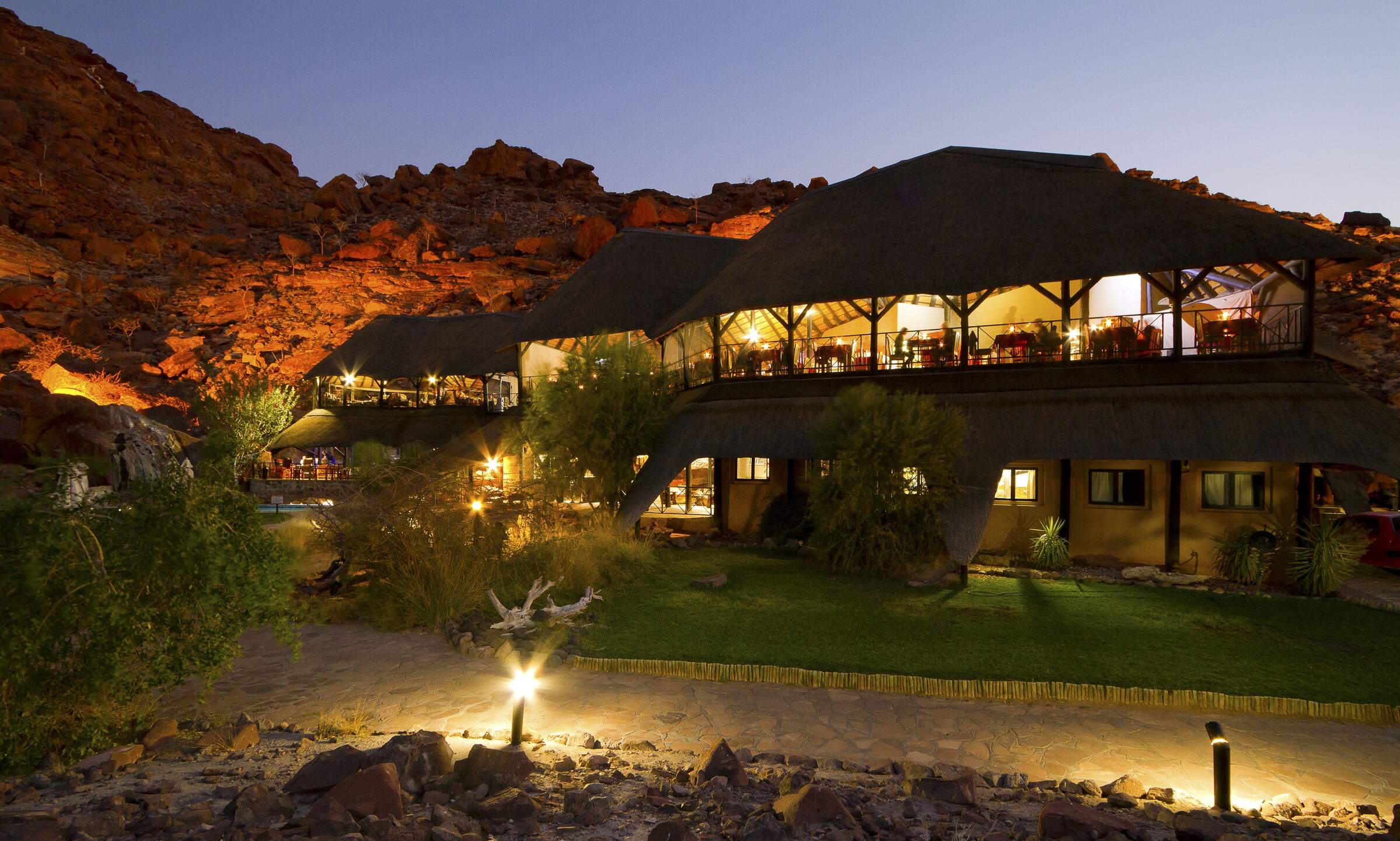
Twyfelfontein C'try Lod.
A large lodge set among the rocks, Twyfelfontein Country Lodge is a convenient base for visiting the rock engravings, which are only 4km away.
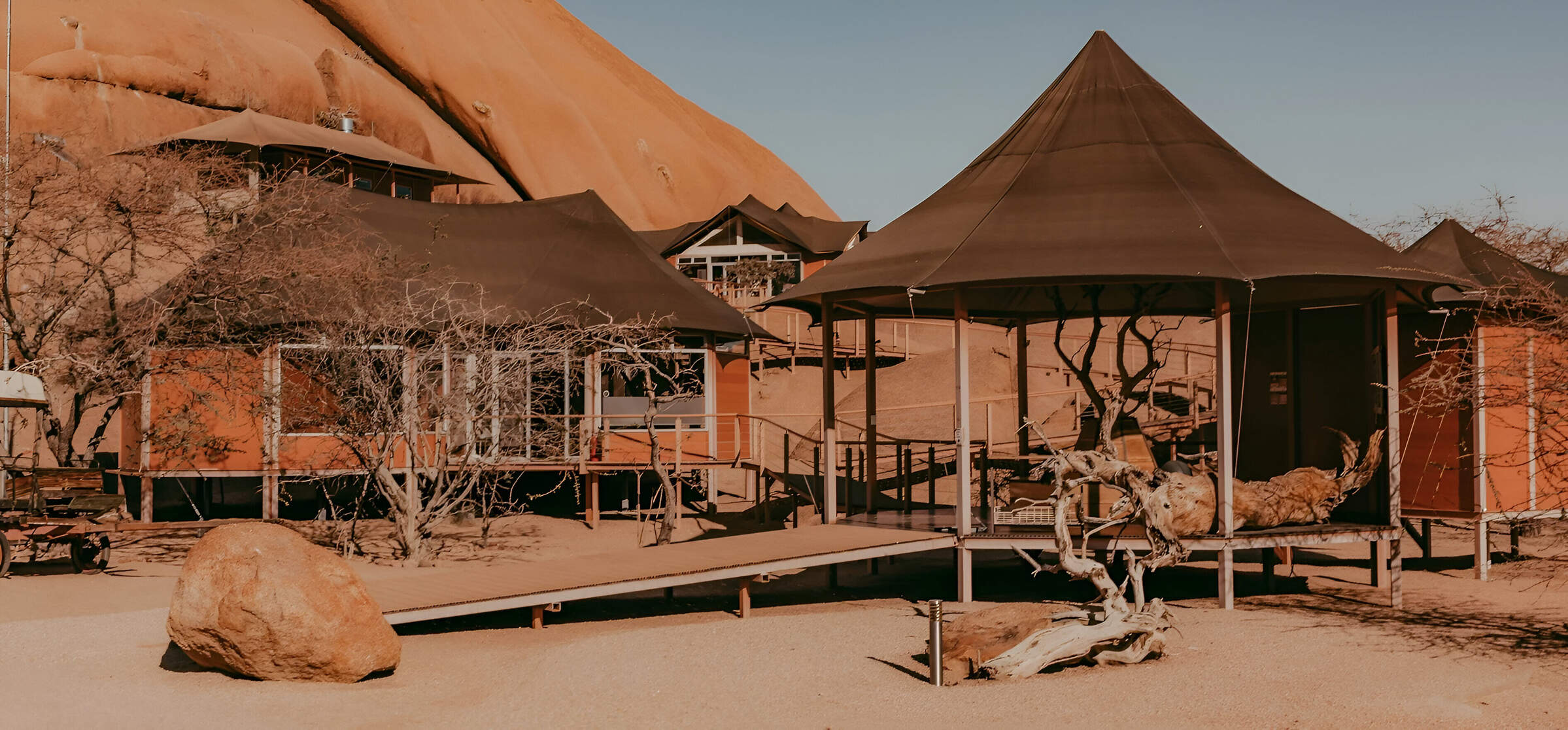
Spitzkoppen Lodge
Spitzkoppen Lodge provides stylish accommodation in an area of scenic grandeur with guided access to sites of ancient Bushman rock art.
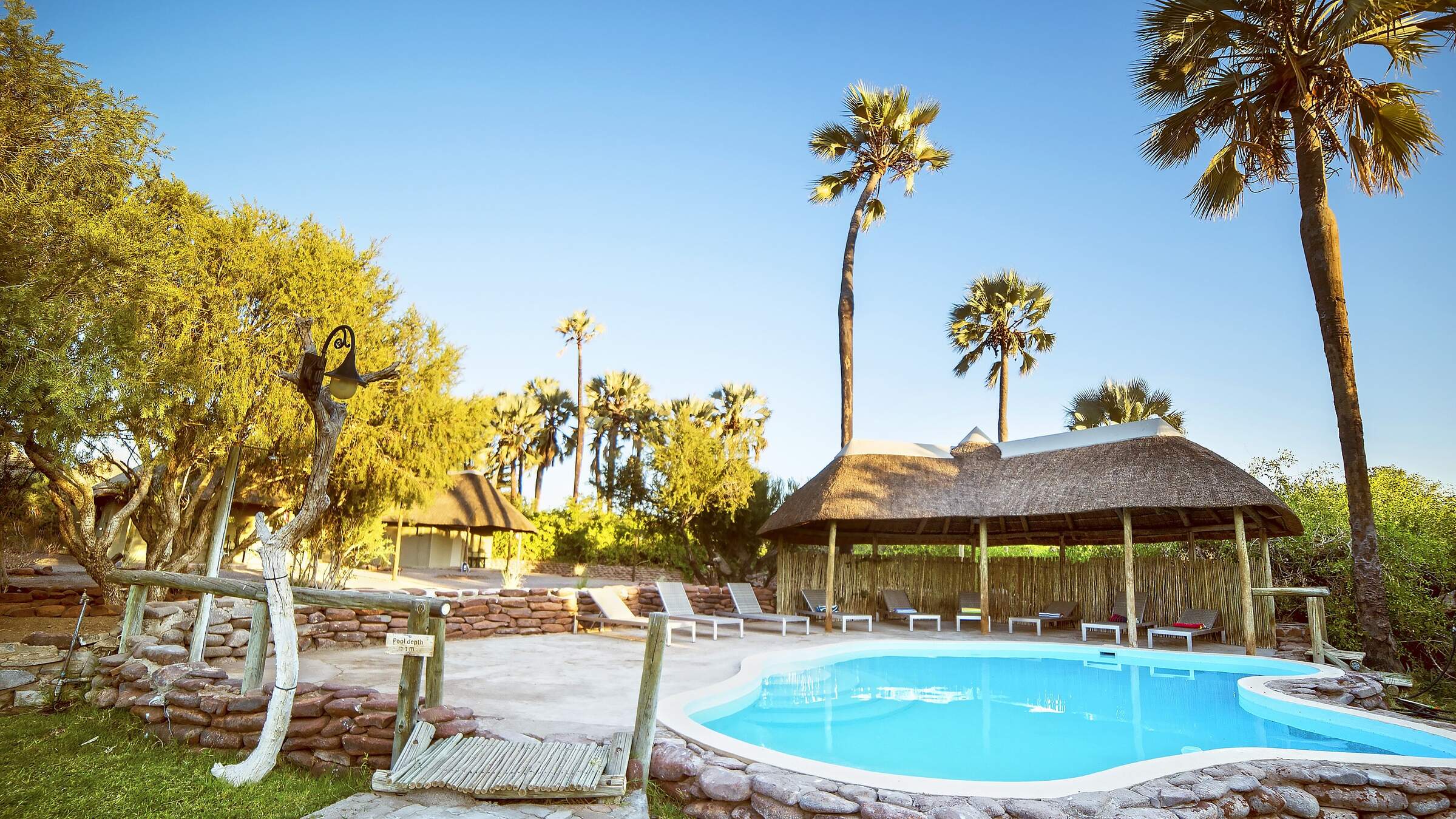
Palmwag Lodge
Palmwag Lodge has a great location by a spring in the Uniab River and offers access to an area where you can see a variety of desert-dwelling animals.
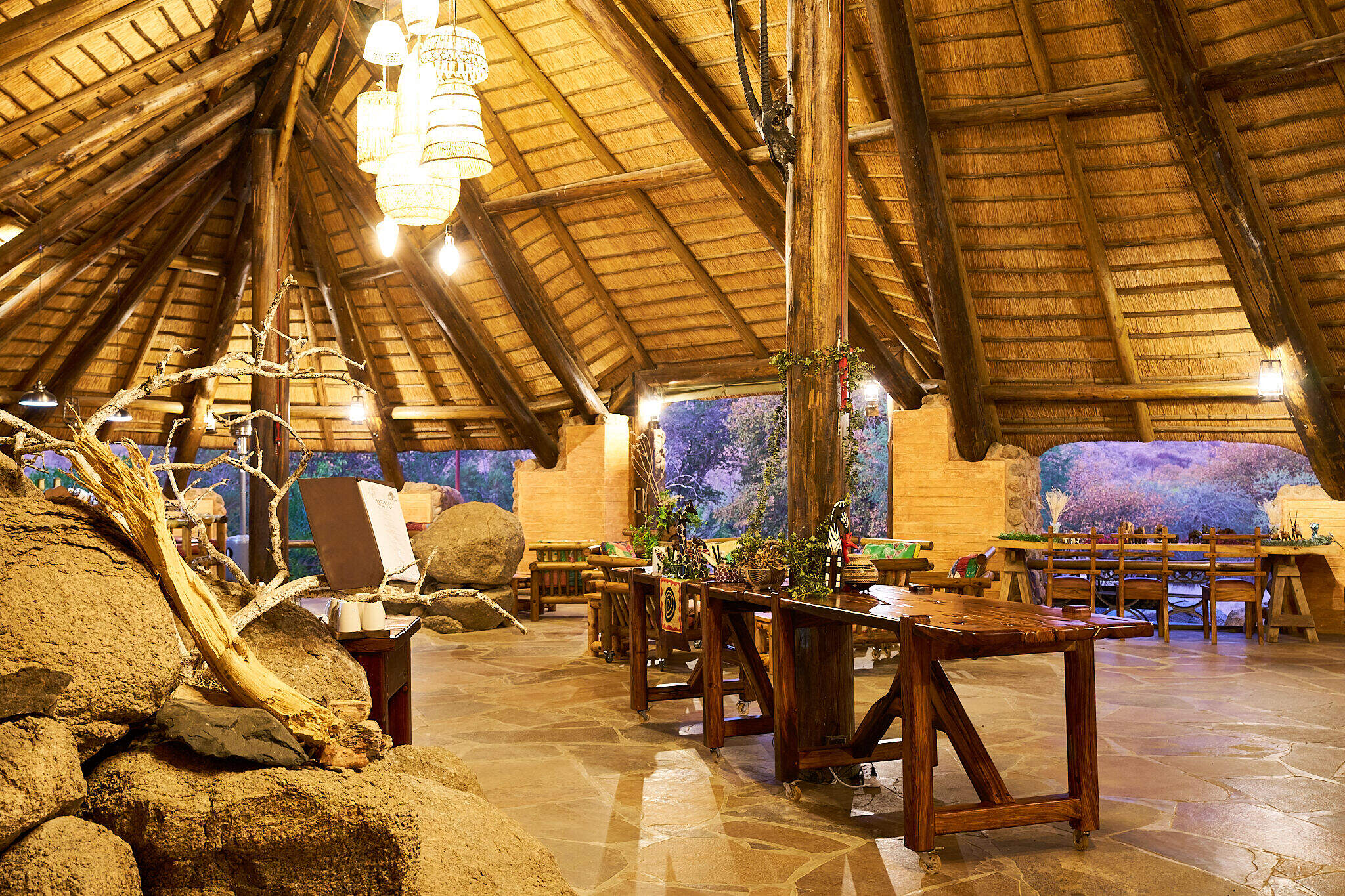
Huab Lodge
Huab is a classic little Namibian Lodge which is slightly off the beaten track in a lesser visited part of Damaraland.
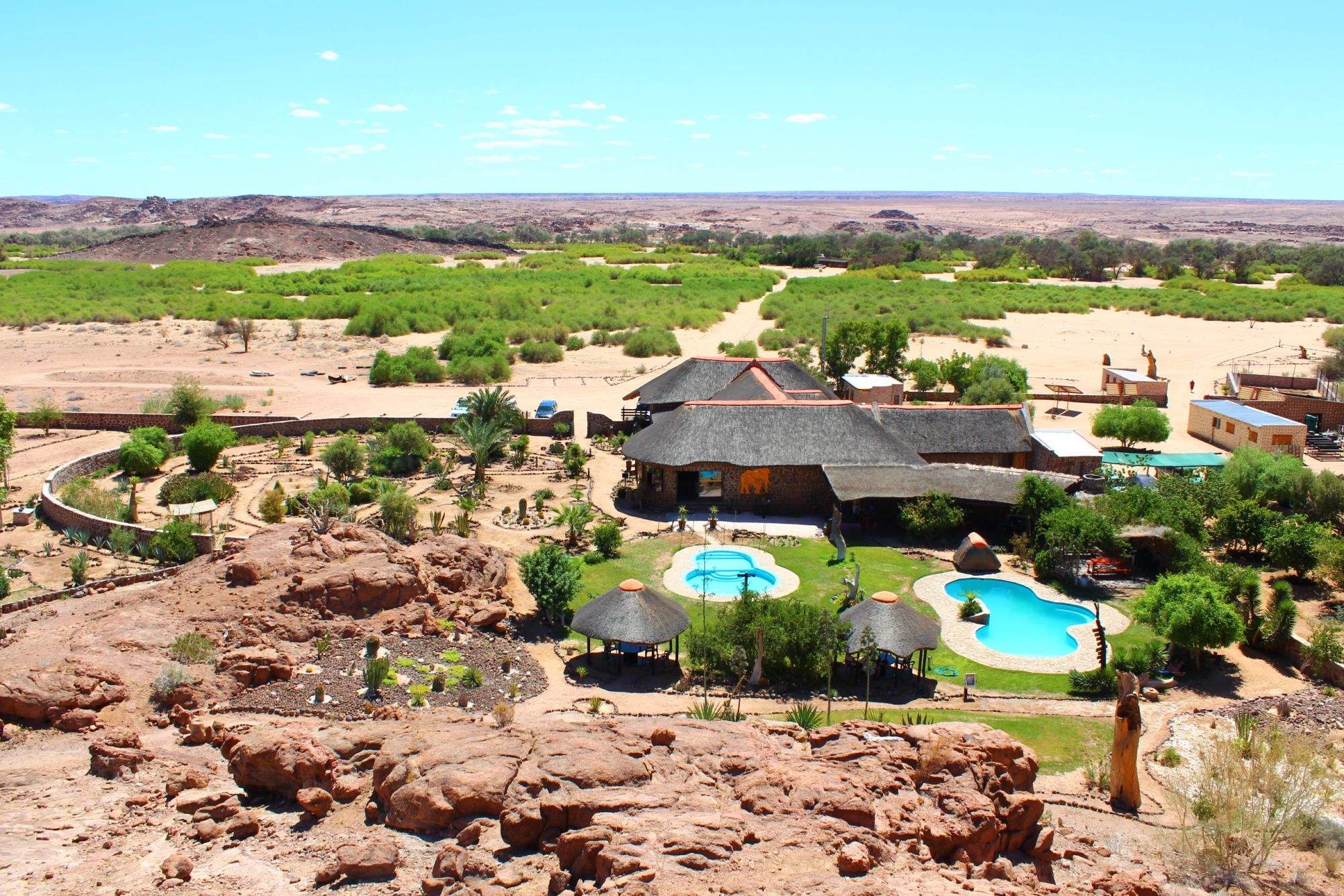
Brandberg White Lady
Brandberg White Lady Lodge, nestled at the foot of its namesake, makes a good base from which to visit bushman rock paintings including the 'White Lady'.
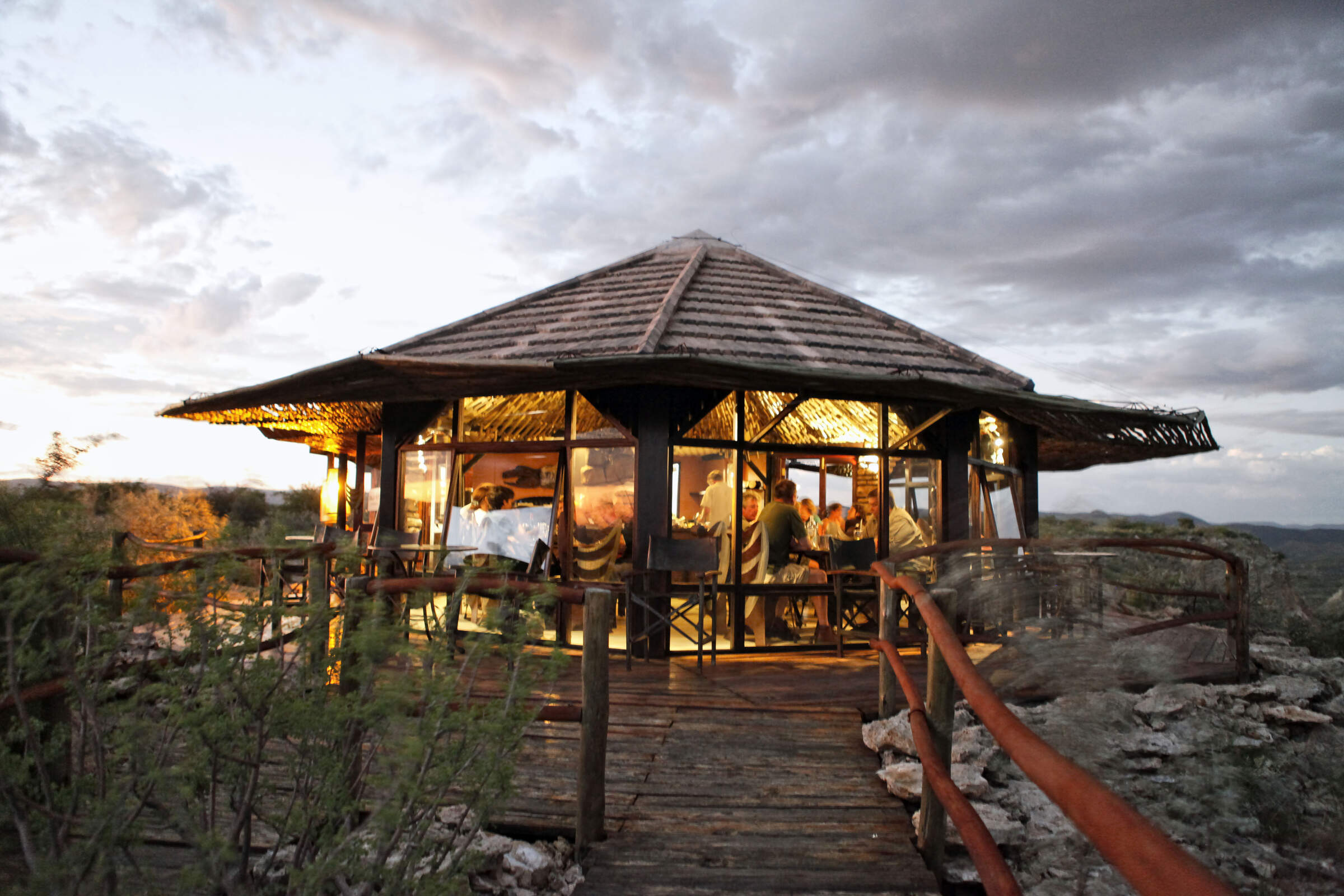
Vingerklip Lodge
Vingerklip Lodge occupies a lovely location, but is a little too far east for guests to visit Damaraland's main attractions.
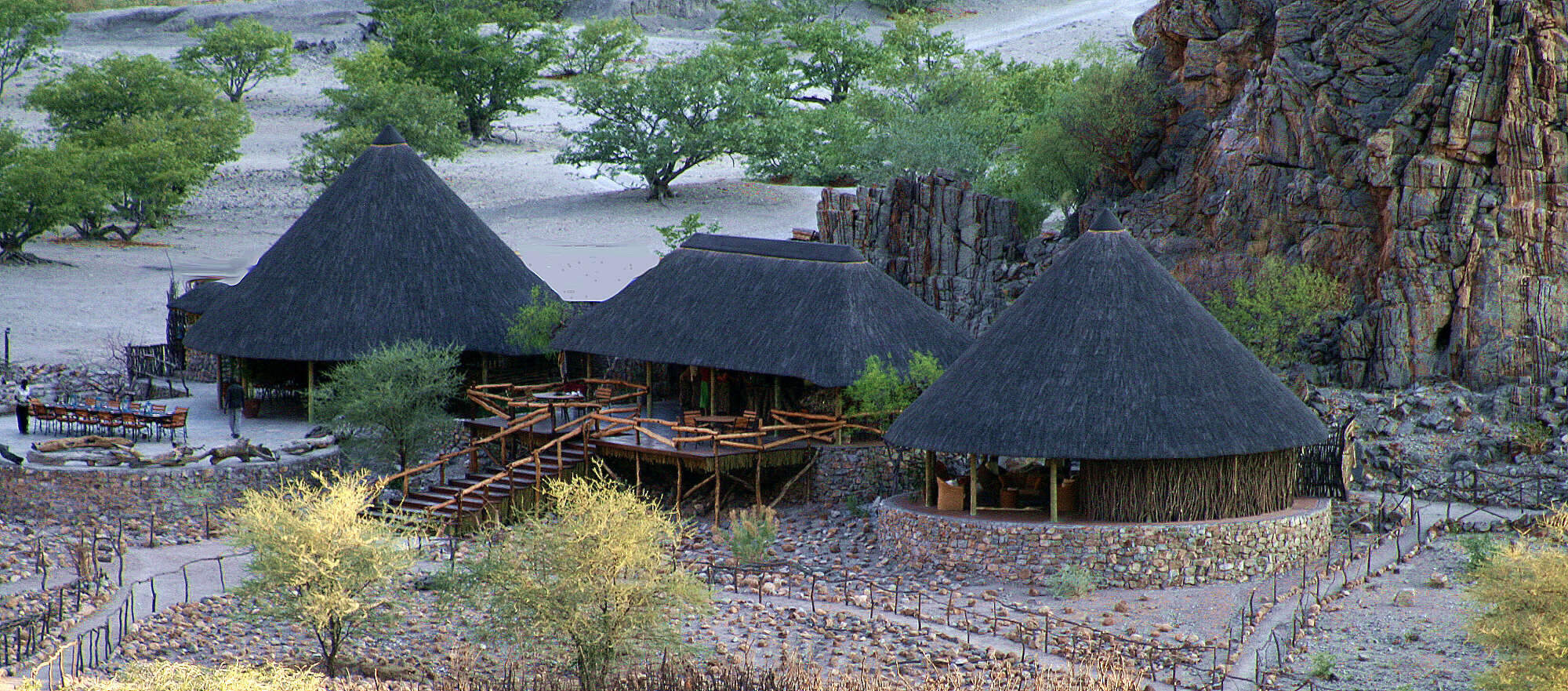
Khowarib Lodge
Khowarib Lodge has a great location overlooking the Hoanib River. This is one of the few places to offer authentic Himba village visits.
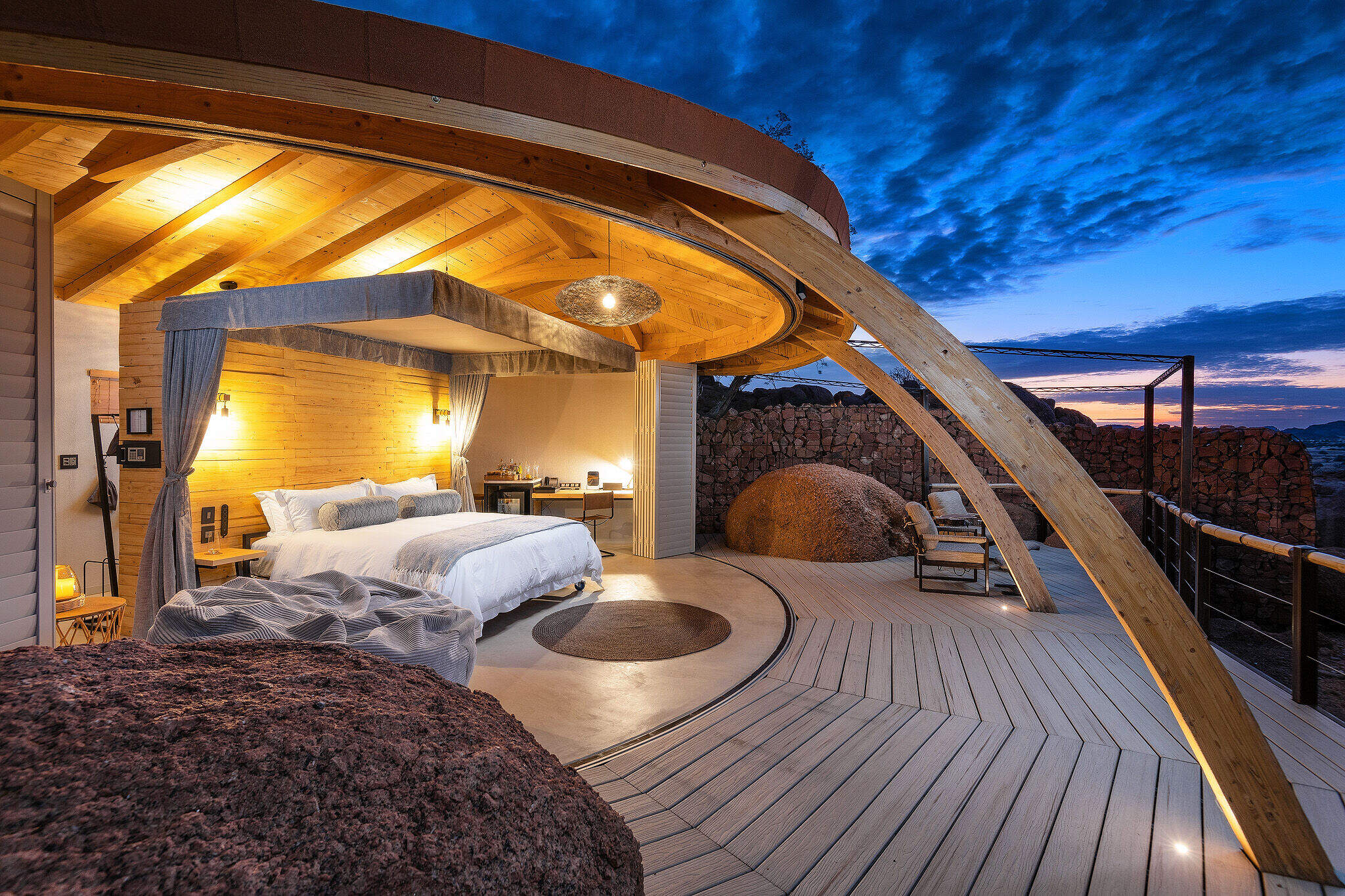
Onduli Ridge
Onduli Ridge is a luxurious, low-impact luxury camp offering top-notch guiding in a remote wilderness area of Damaraland.
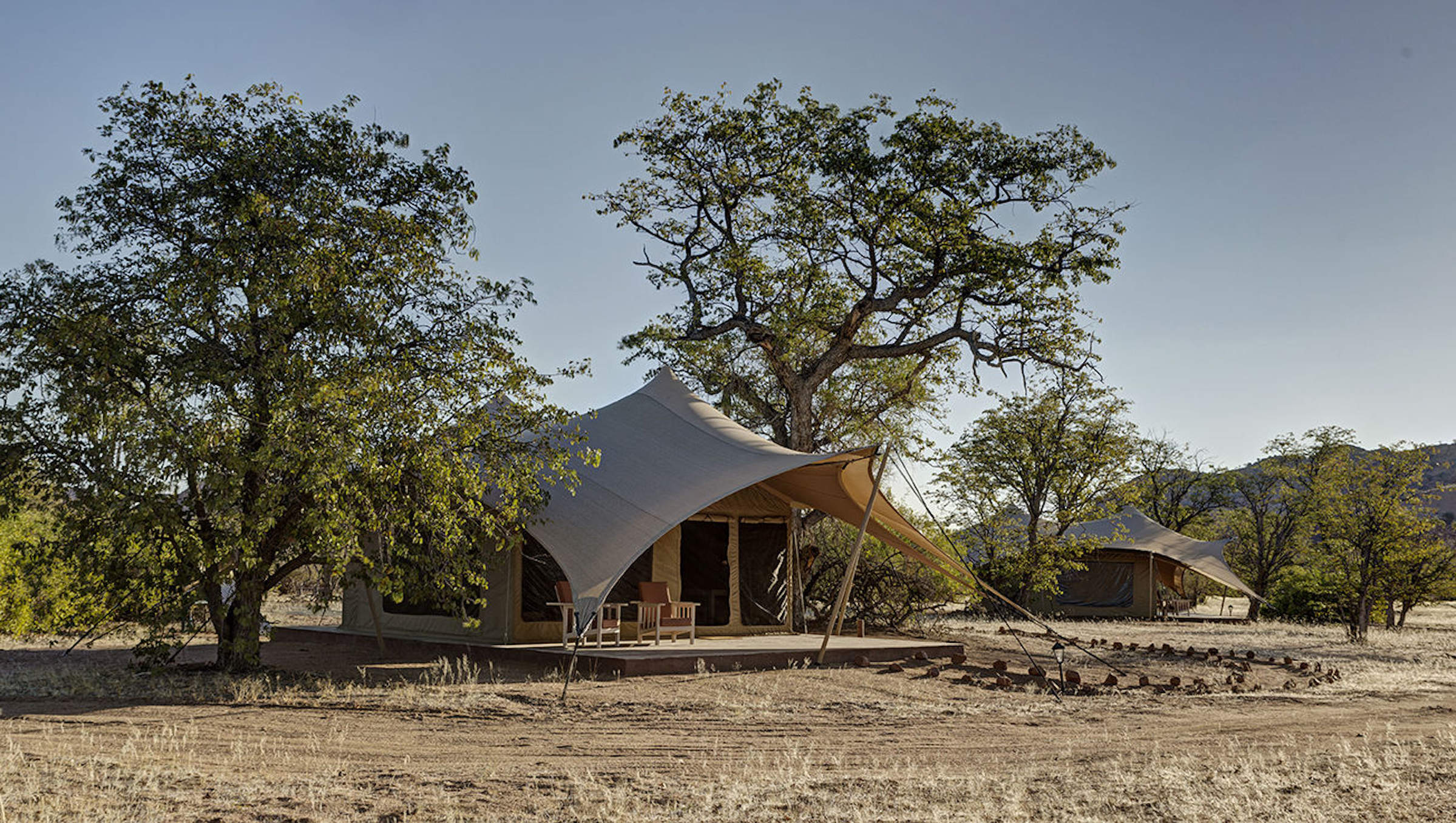
Malansrus Camp
Within easy reach of Twyfelfontein, Malansrus offers a simple but comfortable base for visits to the rock engravings or seek out desert-adapted elephants.
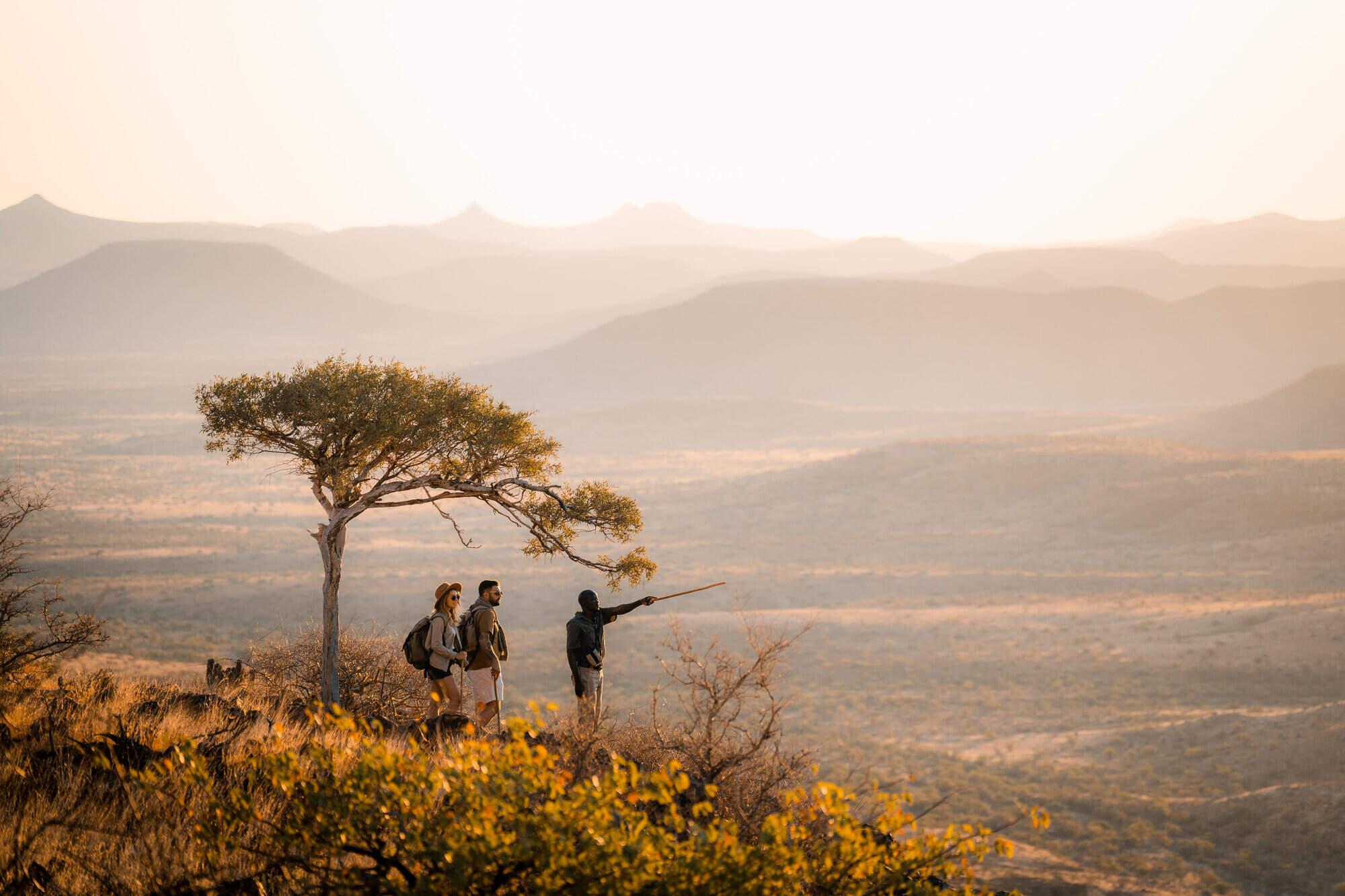
Etendeka Walking Trail
The Etendeka Walking Trail promises to offer a back-to-basics walking and camping experience in one of Namibia's most remote and untouched wilderness areas.
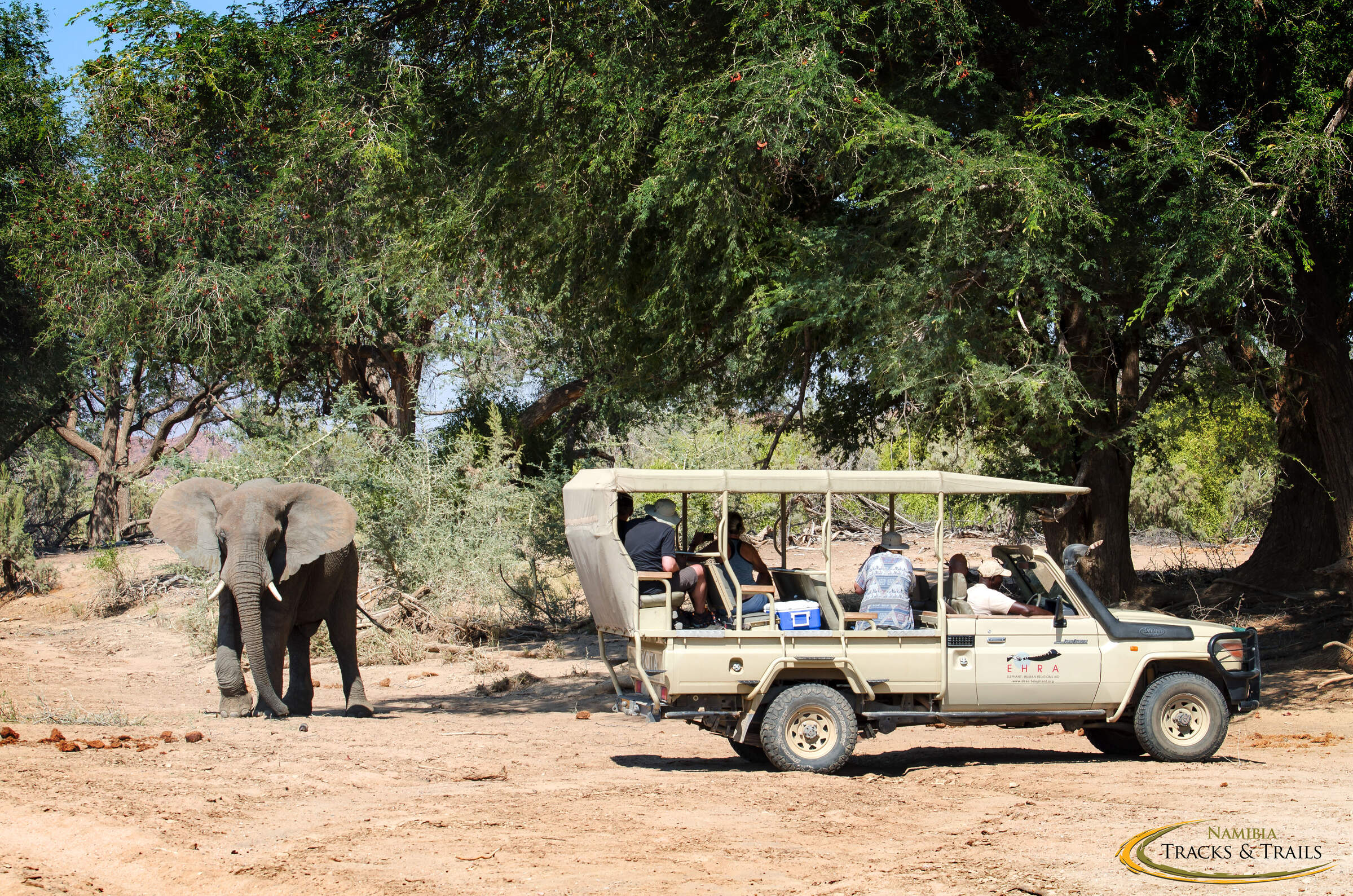
Ozondjou Trails
The simple Ozondjou Trails gives a unique perspective on living with Damaraland’s desert-adapted elephants and how tourism is key to protecting them and the livelihood of the people.
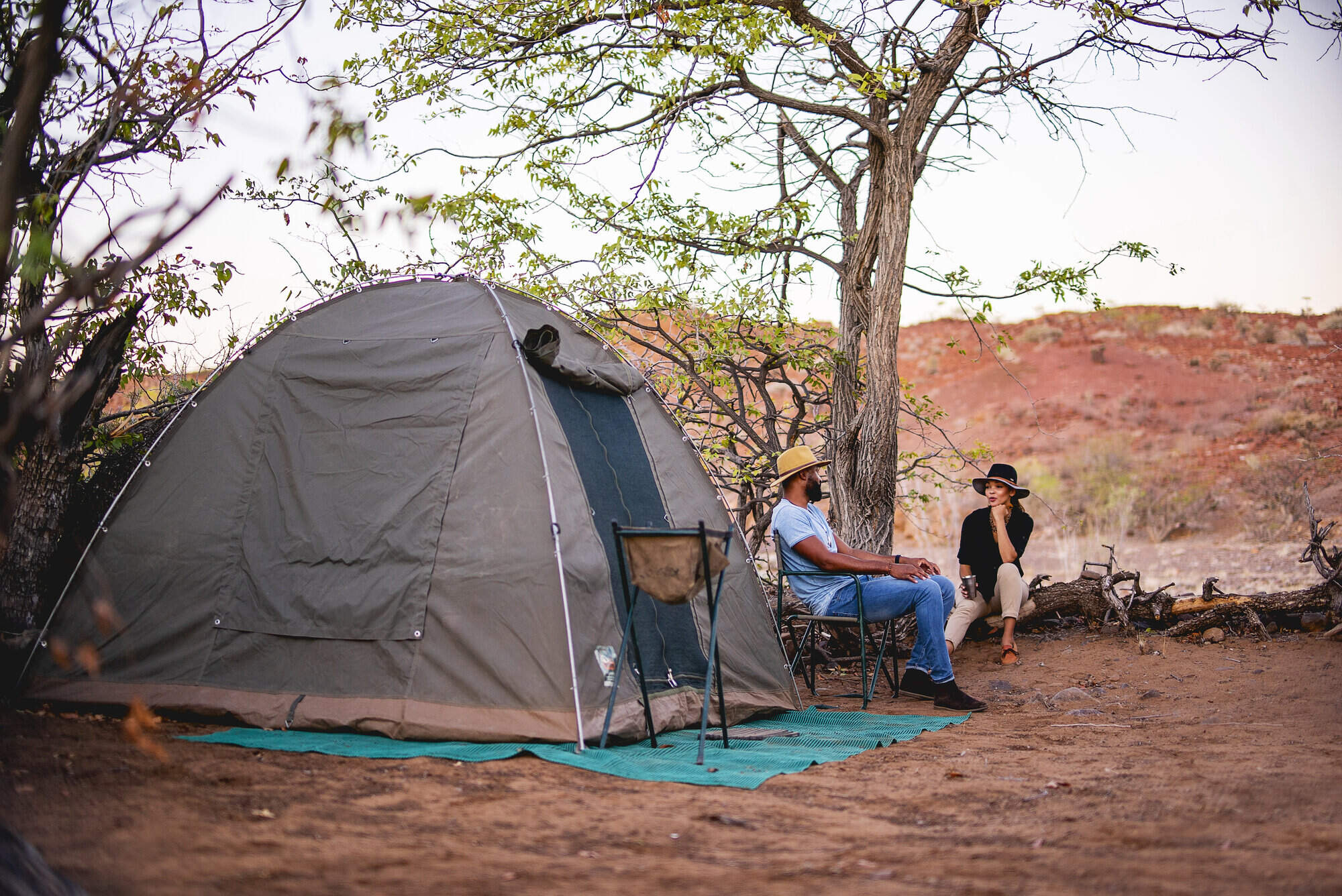
Palmwag Sleep-out
Palmwag Sleep-out is a simple camping experience and a great way to enjoy the remote beauty of the vast Palmwag Concession
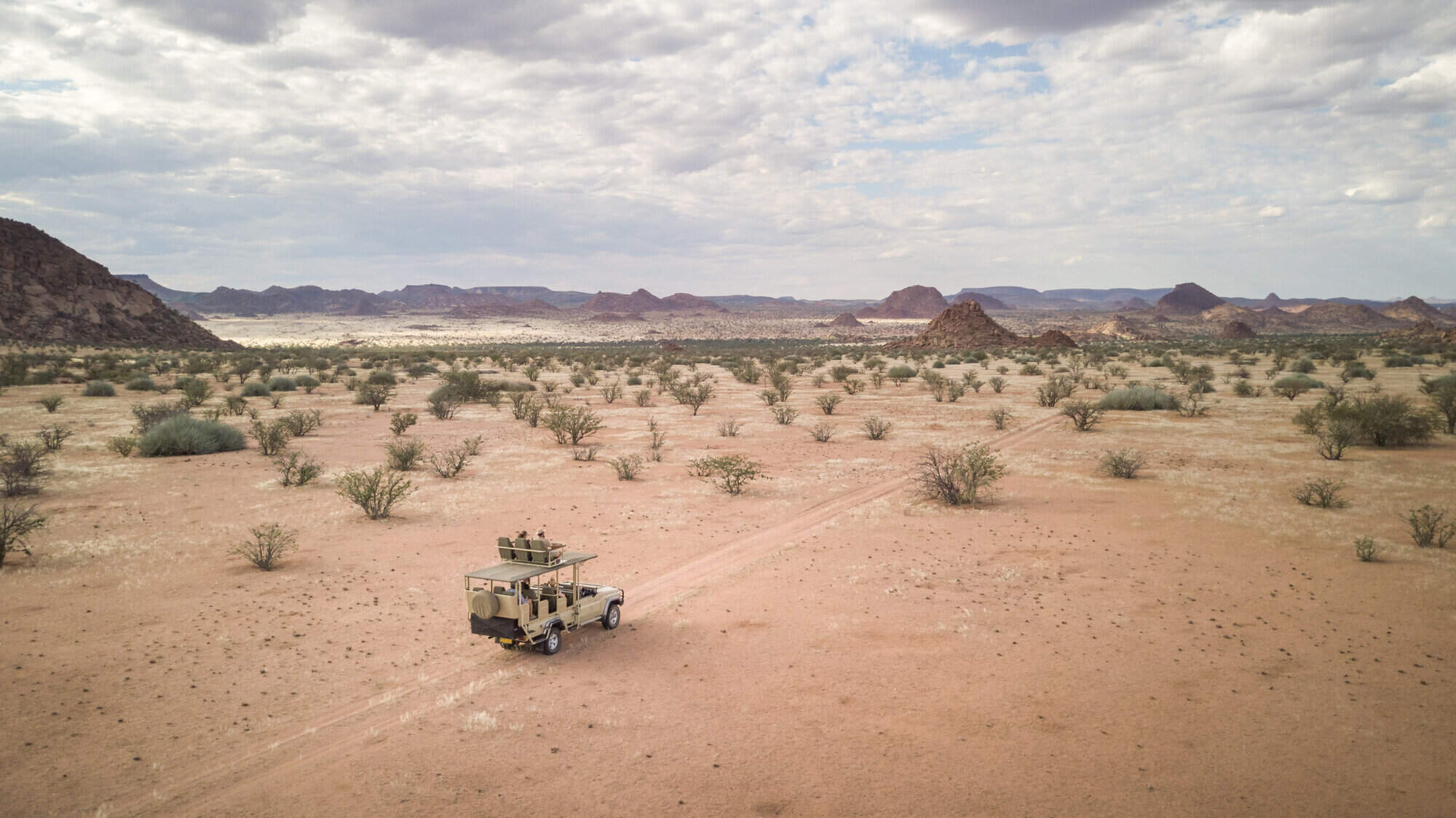
Camp Doros
Small, intimate and with excellent eco-credentials, Camp Doros is set above an ephemeral river within a remote community concession of Damaraland.
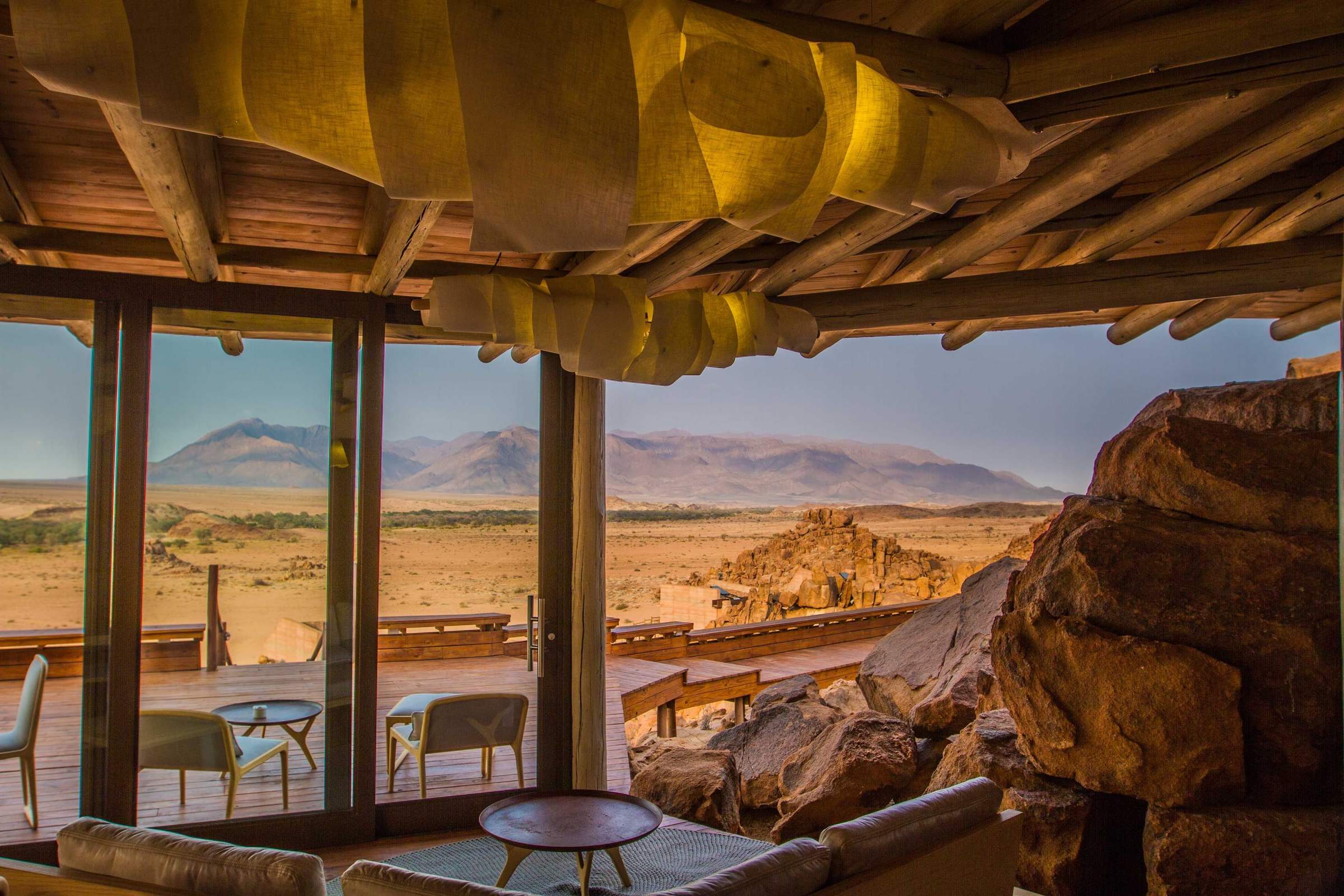
Sorris Sorris Lodge
Overlooking the Brandberg Massif, Sorris Sorris is probably the most luxurious lodge in southern Damaraland.
When to go to Damaraland
Our month by month guide: What it's like to visit Damaraland Camp in Damaraland
Jan
Feb
Mar
Apr
May
Jun
Jul
Aug
Sep
Oct
Nov
Dec
Damaraland in January
In Damaraland, January marks the start of the rainy season. The rains, though often light and localised, bring life to the desert landscape.
At Twyfelfontein, the rock engravings glisten after sporadic showers. Some days are clear and hot, with temperatures around 30°C/86°F, while others see dramatic thunderstorms. These can create flash floods in ephemeral riverbeds like the Ugab, temporarily transforming the arid terrain. The greening landscape provides a refreshing backdrop for the ancient rock art at Brandberg Mountain.
Many birds in the region are in full breeding plumage, with migrant species adding to the variety. Wildlife, including the desert-adapted elephants, disperses across the rejuvenated landscape, making sightings more challenging, but rewarding. The Damara Living Museum offers insights into how local communities adapt to these seasonal changes.
- Variable weather: hot, dry or humid with rain
- Occasional localised thunderstorms
- Wildlife dispersed, harder to spot
- Stark mountains against atmospheric skies
- Few tourists, low rates at accommodations
Our view
This is not a great time to visit
Weather in January
Damaraland in February
February is typically the wettest month in Damaraland, though rainfall remains patchy across this predominantly arid region.
The Spitzkoppe granite peaks against thunderous, atmospheric skies create dramatic vistas for photographers. Some days are clear and hot, while others see afternoon thunderstorms that briefly but dramatically charge the landscape. These rains can make travel more challenging, especially to remote sites like the Epupa Falls. However, the landscape feels vibrant and alive, with insects and smaller animals more easily spotted, and seasonal flowers blooming. Many birds and animals are raising their young, offering unique wildlife viewing opportunities.
Despite the rains, the rock art at Twyfelfontein and the Petrified Forest remain accessible.
- Hot and humid with occasional rain showers
- Thunderstorms meander over the landscape
- Birdlife spectacular, migrant species present
- Wildlife harder to see, but landscape lush
- Low tourist numbers, great for solitude
Our view
This is not a great time to visit
Weather in February
Damaraland in March
March in Damaraland usually sees the main rains tailing off, though precipitation varies greatly across the region. Many days are clear, with strong sun driving temperatures up, while others may experience light rainfall.
The landscape often appears vivid and green, providing a striking contrast to the bare rocky outcrops of Spitzkoppe and Brandberg. Animals such as springbok and mountain zebra may be finishing raising their young. Small herds of plains game such as these can be more visible against the greener backdrop. The Damara Living Museum showcases how local communities adapt to these seasonal changes. The clearer skies towards the end of the month make for excellent stargazing at lodges where you can move your bed to sleep under the stars.
- Weather becoming drier as month progresses
- Animals looking healthy after months of plenty
- Balmy nights sleeping under star-filled skies
- Migrant birds begin to depart
- Few tourists, rates often low at lodges
Our view
A good time to visit, with pros & cons
Weather in March
Damaraland in April
April in Damaraland is typically dominated by dry weather, with decreasing chances of rain. Temperatures begin to fall, but days remain pleasantly warm. The rains often leave the landscape verdant, creating stunning photo opportunities at sites like the Etendeka Plateau and Klip Valley.
Animals are in fantastic condition, often with fast-growing young in attendance. The desert-adapted elephants may be more easily spotted as they begin to return to the riverbeds to feed on Ana and Camelthorn trees. With dust washed from the atmosphere, photographers can capture clear shots of spectacular landscapes. Stargazers will enjoy increasingly clear night skies. In the Palmwag Concession, water and food remain in plentiful supply, so finding mammals such as black rhino can still be challenging, but worth the effort.
- Cooler nights, days still warm and pleasant
- Landscape still green from recent rains
- Air clear, for crisp photographs
- Wildlife starting to become easier to find
- Easter sees an increase in visitors
Our view
A good time to visit, with pros & cons
Weather in April
Damaraland in May
By May, Damaraland is usually drying out fast. If rains have been good, the land remains green, especially around natural springs found in valleys and craggy rocksides. The air quality and clarity can be amazing, making this an ideal month for photography at sites like Twyfelfontein and along the remote Hoanib riverbed.
Temperatures are moderate, typically warm with crisp, clear mornings and blue skies. Evenings are cool enough to wear an extra layer. Many lodges still charge low season prices, offering good value. The combination of increasingly good wildlife sightings, beautiful landscapes, and crystal-clear air make May one of the best months to visit Damaraland. It's an excellent time to explore the region's geological wonders, such as the ancient Etendeka lava flows.
- Lovely weather: warm days, cool nights
- Landscape drying out, still some greenery
- Clear, sharp colours for photography
- Wildlife more visible along scenic riverbeds
- Low visitor numbers, moderate lodge rates
Our view
A very good time to visit
Weather in May
Damaraland in June
June sees Damaraland dry and clear, with blue, largely cloudless skies. Days are often lovely and warm, but nights can be cold, sometimes below freezing in desert areas.
Visitors should pack warm clothing for early morning nature drives to spot desert-adapted elephants or black rhinos. Most outdoor pools are too cold for swimming, except for the very dedicated. It’s a particularly good climate for walking; either short walks or perhaps a multi-day hike on the Etendeka Plateau.
Historically, June prices have been low, but Damaraland's increasing popularity means many lodges now consider it high season.
- Clear, bright days and cold nights
- Wonderful for stargazing and night walks
- Good wildlife viewing in remote wildernesses
- Hiking comfortable in cooler temperatures
- Moderate lodge rates, increasing bookings
Our view
A very good time to visit
Weather in June
Damaraland in July
July in Damaraland offers fairly warm temperatures above 20°C/68°F in the middle of the day, but often cold nights. Visitors should dress in layers and be prepared for chilly mornings and evenings.
Rain is extremely rare, and clear skies make for great photographs of the sandstone mountains in morning and evening light. As vegetation shrivels, animals gather near food and water sources, making sightings of desert-adapted wildlife more likely. Elephant herds are more regularly seen along dry riverbeds during this period.
Lodges charge high season rates, and many are booked up well in advance, especially during European school holidays.
- Dry days, clear skies, crisp cold nights
- Peak time for wildlife viewing in Damaraland
- Desert-adapted elephants more easily spotted
- Wonderfully cool for day walks and longer hikes
- High season rates, book accommodations early
Our view
A very good time to visit
Weather in July
Damaraland in August
August is the height of Damaraland's winter. Expect cloudless skies and usually warm sun during the day, but nights can drop to freezing in desert areas. Visitors should bring warm clothes for nature drives and walks in chilly mornings and evenings.
The landscape begins to change from green to golden grasses and stark hillsides. Wildlife sticks close to dry river-beds where desert-adapted elephants dig for water, creating waterholes for other animals.
The clear, dry conditions make it an excellent time for hiking and exploring geological features like the Organ Pipes and Burnt Mountain.
August is the most popular time to visit Damaraland, especially for families. Booking well in advance is essential.
- Perfect weather for outdoor activities
- Excellent wildlife viewing opportunities
- Popular time for hiking and tracking rhino on foot
- Good time for cultural experiences at Damara Living Museum
- Peak season, lodges booked up well in advance
Our view
Fantastic: the very best time to visit
Weather in August
Damaraland in September
September in Damaraland brings blue, cloudless skies and fantastic wildlife viewing. Rain is almost unheard of, and as the month progresses, days and nights quickly get warmer. Daily maximums can reach the low 30s Celsius/mid-80s Fahrenheit, though low humidity keeps it comfortable. The air becomes dustier, occasionally affecting visibility for photographers at sites like Twyfelfontein or Brandberg.
In the Palmwag Concession and along the Ugab River, animals congregate around remaining water sources, making September one of the best months for game viewing, especially for desert-adapted elephants and black rhinos, but also desert-adapted lion. It's a popular month for visitors, particularly safari enthusiasts seeking sightings of these unique sub-species.
The Himba at Khowarib provide insights into how local communities adapt to the dry season.
- Warm days, nights getting warmer
- Landscape golden brown, very photogenic
- Prime time for seeing desert-adapted wildlife
- Air can be hazy with dust
- High season rates, book well in advance
Our view
Fantastic: the very best time to visit
Weather in September
Damaraland in October
Damaraland is usually at its hottest and driest in October. Temperatures build throughout the month, with daily highs potentially exceeding 40°C/104°F towards the end. The extreme dryness, though, makes even these high temperatures bearable.
Wildlife watching is at its best, particularly in areas like the remote Palmwag Concession and along the Hoanib River. October is popular among wildlife enthusiasts, as shyer species such as brown hyena and cheetah are more regularly seen. However, dust and occasional smoke may make the air hazy, challenging landscape photographers but creating beautiful sunsets.
Visitor numbers can decrease towards the end of the month, potentially allowing for last-minute bookings at some lodges.
- Hot and dry, true desert conditions
- Wildlife congregates at remaining water
- Excellent month for photographing sunsets
- Peak tourist time, expect higher rates
- Unusual species like brown hyena more regularly seen
Our view
A very good time to visit
Weather in October
Damaraland in November
November in Damaraland is unpredictable; sometimes dry and hot, sometimes cloudier and cooler. Typically, mornings are hot and clear, with clouds gathering from the afternoon. Humidity builds, occasionally resulting in spectacular thunderstorms with convection rainfall in late afternoons. These storms are usually localised and may not reach desert areas.
Places receiving good rain, like parts of the Palmwag Concession, quickly turn green, softening the landscape. Many mammals give birth, offering unique wildlife viewing opportunities. Once rains settle in waterholes, wildlife disperses in search of food, making game viewing more challenging. However, this is an excellent time for birdwatchers, with migrant species arriving and taking on breeding plumage.
The rock art at Twyfelfontein and Brandberg can be particularly striking after light rains.
- Variable weather, possibility of rain
- New growth if rains arrive, landscape greens
- Wildlife viewing still good, with babies often born
- Shoulder season rates offer better value
- Birdlife increases with migrant arrivals
Our view
A good time to visit, with pros & cons
Weather in November
Damaraland in December
December is often a dry month between November’s short rains and the main rains in January, and is one of its hottest months. Occasional short, often spectacular thunderstorms are often highly localised and generally welcomed, clearing the air of dust and allowing plant life to flourish. This creates a green carpet across the usually arid landscape, providing food for young animals.
Wildlife, including the desert-adapted elephants, disperses widely as food is more plentiful, making game viewing in areas like the Palmwag Concession more challenging. But sightings in early December can be enjoyed and photographed at leisure often with few or no other viewers. Many birds are breeding, sporting their most colorful plumage.
Christmas and New Year fall within local summer holidays, so accommodation options can be surprisingly busy, especially in cooler areas near the coast.
- Hot days, possibility of refreshing showers
- Landscape may become green with early rains
- Good time for seeing young animals
- Desert-adapted species less concentrated
- Holiday season brings more visitors
Our view
This is not a great time to visit
Weather in December

Looking for inspiration on where to travel next?
Visit our trip chooser to explore your options and find inspiration for your perfect African adventure
Inspire me
